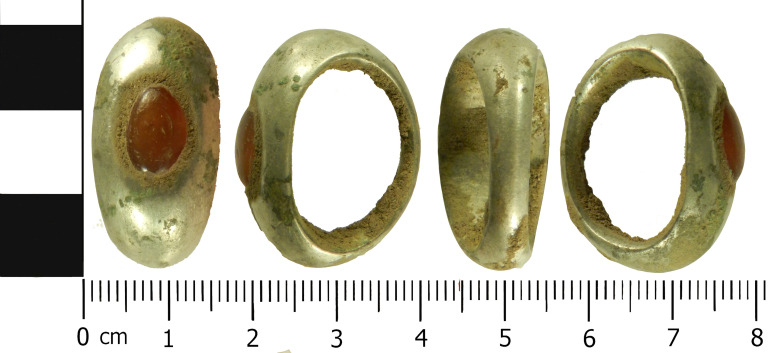Reports
- Details
- Category: Reports
History of Victorian Costume and Social Change.
Thursday 14th March 2019 by Barbera Joyce on "100 Years of Costume Drama.How clothes reflect social change in the 19th century".
On Thursday evening the 14th of March 2019 members and one visitor enjoyed a vivid description of the change in costume of men and women during the Victorian era. The talk was illustrated by images of clothes from the various decades of the Victorian period.

source unknown ex Wikipedia commons public domain Victorian Fashions.

Ex Wikipedia: [Picture is currently in a private collection] A Private View at the Royal Academy, 1881 is a painting by the English artist William Powell Frith exhibited at the Royal Academy of Arts in London in 1883. It depicts a group of distinguished Victorians visiting the Royal Academy Summer Exhibition in 1881, just after the death of the Prime Minister Benjamin Disraeli, whose portrait by John Everett Millais was included on a screen at the special request of Queen Victoria (visible in the archway at the back of the room). The room is Gallery III, the largest and most imposing room at Burlington House.
Frith worked on the painting through much of 1881 and 1882. He later said in My Autobiography and Reminiscences, published in 1887, that "Beyond the desire of recording for posterity the aesthetic craze as regards dress, I wished to hit the folly of listening to self-elected critics in matters of taste, whether in dress or art. I therefore planned a group, consisting of a well-known apostle of the beautiful, with a herd of eager worshippers surrounding him."
The subject of the painting is the contrast between lasting historical achievements and ephemeral fads. The portrait of Disraeli represents the former, and the influence of the Aesthetic movement in dress represents the latter. Aesthetic dress is exemplified by the principal female figures, to the left, in green, pink and orange clothing. Oscar Wilde, one of the main proponents of Aestheticism, is depicted at the right behind the boy in the green suit, with signature lily buttonhole, surrounded by female admirers.
Social Status.
The speaker noted how the illustrations and recorded descriptions of people’s clothes were very much indicators of social status. The wealthy could afford to have clothes made for ordinary use and for display and could preserve them or hand them down to others. Therefore surviving clothing is mainly from the wealthy whose clothes were not subject to rough work or wear.
Society was stratified and the clothes of the wealthy group changed with fashion and influenced the other classes trying to emulate them in dress. As display symbols of wealth some types of clothing needed extreme care and maintenance to ‘keep their looks’.
The subject of clothing in that era has considerable documentation and many available studies and websites devoted to it, and so the speaker talked mainly about the wealthier class.
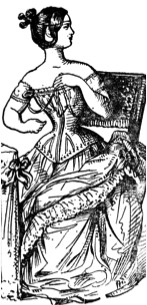
An 1837 dress showing the tight waste and corsetting.

1844 fashion plate depicting fashionable clothing for men and women.
Fasion plate girls 1870 French Magazine

1861 Victorian mens costumes plate 1

Victorian mens costumes plate 2. Top Hats were an expensive item and required hours of maintenance.
Change in cost and method.
At the start of the Victorian era most clothes were hand made and hand cut and sewn. As the period developed the fruits of the industrial revolution and the availability of cotton made great changes. The sewing machine altered both household ability to make clothes and in industrial factories led to mass market cheaper clothing.
Cotton thread and the sewing machine revolutionised clothing manufacture.
Clothes were changed many times per day by the wealthy and the up and coming middle classes who could afford to emulate them. Morning dress, day dress and evening dress developed with subsets of evening dress for ladies depending on the event to which people were going.

1880s Evening Dress. Dresses Cut low for some events but high for others. Do not make a mistake about the rules!

A comment on dress which shows both the pose, and the middle class children's holiday dress.
Second hand market and business. A very large industry.
As wealth and leisure dictated the higher fashions, after use or when unfashionable these clothes were disposed of to the second hand market or distributed to servants who wore or changed the clothes to suit their purposes. The business of making new clothes ran alongside a much larger trade in altering and selling second hand, or third hand or fourth or fifth hand clothing.
As long as it was still wearable there was a market for it. Such large usually unlicensed or irregular markets also gave cover for more dubious or criminal activity in some parts, with some dealers handling both legitimate clothing and other illegal business. The ‘Petticoat Lane’ market in London existed from its ‘Hog Lane’ Tudor name to ‘Petticoat Lane’ in early Victorian times but changed its name to ‘Middlesex Street’ in the 1830s and only became a licensed formal market place in 1930.
Social change.
As the wealthy displayed, and changed fashion it was then as now, important for some people to ‘keep up with your peers’ in display matters, and changes occurred and worked down though the emerging middle class and by the second hand market route was seen later on the poor, although altered to suit their daily use.
The increasing cash available to the middle and working classes changed the range and availability of clothes and footwear from the beginning of the Victorian era to its end, and industry developed mass market clothes to sell to them.
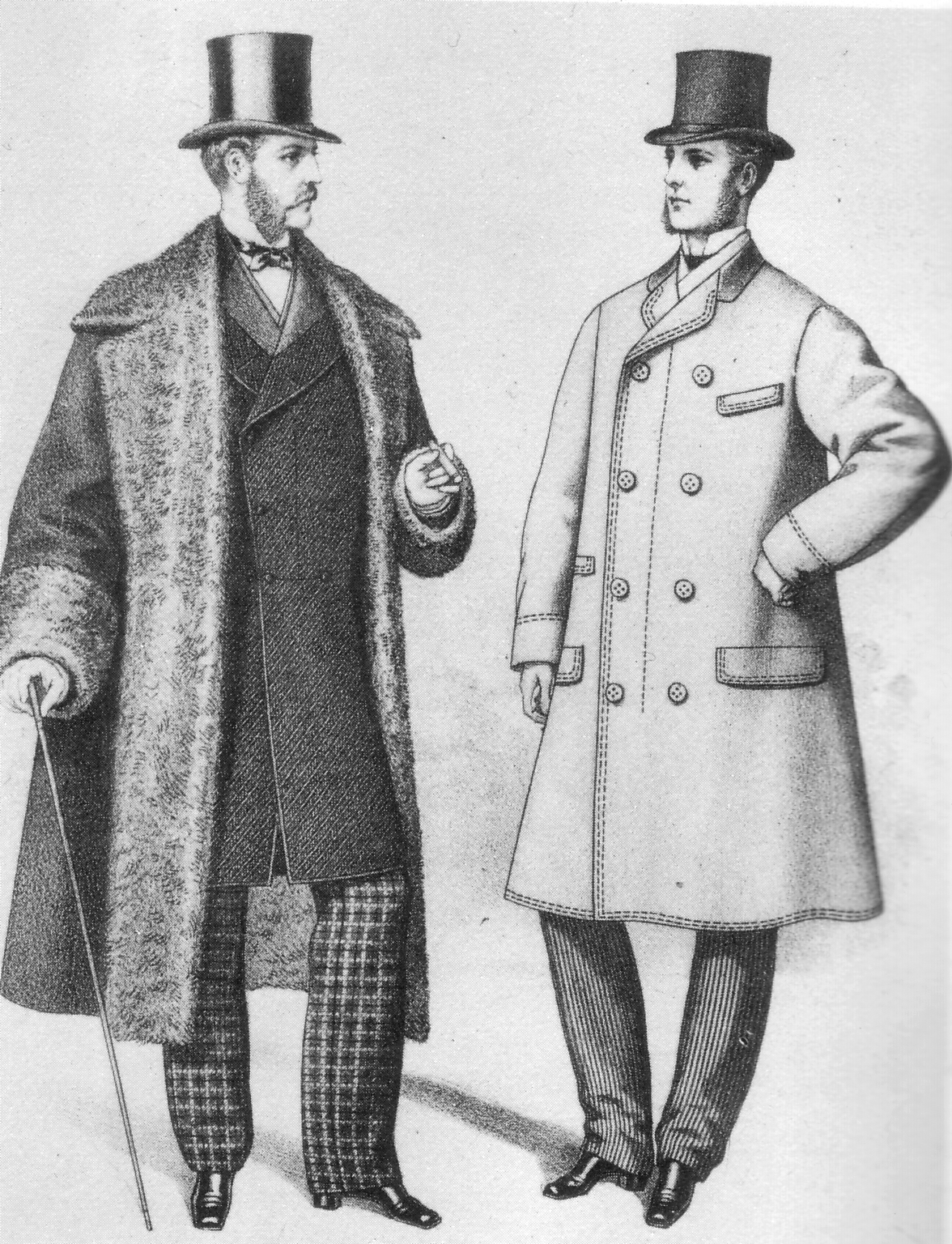
PublicDomain Overcoat left and topcoat right from The Gazette of Fashion 1872 5 187 Mens Coats 1872 Fashion Plate
Crinoline and mass manufacture.

From USA, LA County Museum Of Art Woman's Cage Crinoline LACMA M2007211380
Refer: https://en.wikipedia.org/wiki/Crinoline
With the replacement of many layers of petticoats by a ‘crinoline’ support frame, ladies were able to walk unhampered by the heavy weight of many cloth or horse hair stiffened petticoats but sitting down could lead to lower body display unless the crinoline was correctly folded for modesty. Thus arose the undergarment knickers industry for ladies who previously had not worn such undergarments.
This became a large manufacturing industry in many materials with steel forms being easy to manufacture, fold and ship to market.
Image: Woman's Cage Crinoline Image
Description: English:
England, circa 1865
Costumes; underwear (lower body)
Cotton-braid-covered steel, cotton twill and plain-weave double-cloth tape, cane, and metal
Center back length: 36 1/2 in. (92.71 cm); Diameter: 38 1/2 in. (97.79 cm)
Purchased with funds provided by Suzanne A. Saperstein and Michael and Ellen Michelson, with additional funding from the Costume Council, the Edgerton Foundation, Gail and Gerald Oppenheimer, Maureen H. Shapiro, Grace Tsao, and Lenore and Richard Wayne (M.2007.211.380)
Costume and Textiles
Date circa 1865
Collection Los Angeles County Museum of Art
Dying.
The advent of chemical dyes during the mid-Victorian period and ability to ‘print’ on cotton made a change in the range and colour of clothes used by people.
Mourning.
As Victorians had a defined ritual for mourning with many subsets of periods and type of dress, a major proportion of the business of dyers was the dying of existing formal clothes black for those who could not afford ‘new mourning clothes.

Public Domain Princess Beatrice mourning
Workers.
From Durham university website for schools.
https://community.dur.ac.uk/4schools.resources/victoriandurham/home8.html
What did the poor wear?
Poor families owned a very few everyday outfits and, if they were lucky, some smarter clothes to wear to church or on special occasions. Many outfits were bought second-hand and were passed down through the family. Clothes would have been mended and patched for as long as possible.
Clothes had to be practical. You had to be able to work in them and they had to last a long time. They were often made from wool or cotton in dark colours as this was cheaper and the dirt didn't show as much. Shoes also had to last a long time. Some people wore heavy boots with thick hob-nailed soles. Women wore caps and bonnets not just to be respectable but to keep hair from getting caught in machines and to fend off dirt and head lice.
Children wore clothes handed down from older family members. Not all families could afford shoes for their children so some had to go barefoot.

Child workers dress main qimg e4e37ced571a198b0ed1e0b57e6a0796 c

Children in corner Katherine Bailey PhD Victorian Era Media Studies main qimg 8afec4

poorer class dress main qimg cbe4847b8a1dcdae9bf83f9d1505cee6 c
Three street children Katherine Bailey PhD Victorian Era Media Studies main qimg 37c43fdabd3e917b651e7c76c4a7817b c

Photograph showing a Victorian family at work making trousers Image courtesy of www.eriding.net poorclothessml
Thanks.
The members and their visitors thank the speaker for her most interesting talk, which took us through a very rapid time of social change reflected in the clothes of people
and changing methods of manufacture.
Some Links for Further Study.
https://www.historic-uk.com/CultureUK/Victorian-Fashion
https://www.fashion-era.com/mid-late_victorian_fashion.htm
http://www.vam.ac.uk/content/articles/h/history-of-fashion-1840-1900/
http://www.victorianweb.org/victorian/art/costume/index.html
http://www.victoriana.com/Fashion/1850sfashion/victorianfashionhistory1850.htm
https://www.fashion-era.com/the_victorian_era.htm
https://en.wikipedia.org/wiki/Victorian_fashion
https://commons.wikimedia.org/wiki/Category:Victorian_fashion
https://en.wikipedia.org/wiki/Fashion_plate
http://victorian-era.org/victorian-era-morality.html
https://www.historicalemporium.com/mens-late-victorian-clothing.php
https://www.historicalemporium.com/how-to-guides.php#fashion
https://www.historyextra.com/period/victorian/stitching-the-fashions-of-the-19th-century
http://www.victorianlondon.org/clothing/secondhand.htm
http://www.victorianlondon.org/professions/secondhandclothes.htm
https://www.youtube.com/watch?v=IS10gTJfnPk
A video on hand stiching of clothes before mass manufacture.
Victorian Hand-Sewing: The Sew and Fell Stitch.
https://www.eastlondonhistory.co.uk/history-petticoat-lane-market
https://www.dbeinla.org/history-of-petticoat-lane
https://www.quora.com/What-clothes-did-poor-Victorians-wear
https://community.dur.ac.uk/4schools.resources/victoriandurham/home8.html
http://www.primaryhomeworkhelp.co.uk/victorians/clothes/buying.html
https://fashionfromthevictorianera.weebly.com/who-wore-what.html
https://en.wikipedia.org/wiki/Crinoline
Poor clothes exQuora main qimg 8afec442d44416c74e876e1844b9adf7 c
- Details
- Category: Reports
2019-02-14 Impromptu
Impromptu Talk replaced scheduled talk.
Our meeting on February 14th, 2019, a talk by Philip Jeffs on “A Basic History of Warrington through Maps” was abandoned due to technical difficulties with the projector-computer combination. The group hopes to enjoy Philip's talk at a later time.
Impromptu Talk.
Marlene Nolan with much professionalism of ‘the show must go on’ type stepped up to the front and gave a much enjoyed impromptu talk on Culcheth’s past.
Marlene showed some slides from her own personal research notes into Culcheth’s past and talked of the persons, places, and change to the area though records she has researched, and answered questions from the audience.
Marlene’s ‘off the cuff’ talk was much appreciated by our members and visitors.
Old Maps
Below by courtesy of the of the National Library of Scotland, and reproduced with the permission of the National Library of Scotland are a couple of early Ordnance Survey maps circa 1900 from the Lancashire Sheet areas of the Ordnance Survey.
These do not show the older Culcheth, but at a time ‘after the railway development’ era, and one should note that our nearby Kenyon Junction is the oldest junction stop, and has entered crime novels due to its fame. The “Culcheth” name itself is not on one of the maps but “Newchurch” is the name given at both east and west of the present village centre, while on the other map “Newchurch” is the village place name with a “Culcheth Hall” nearby also named.


The group thanks Philip Jeffs for his help during an eventful evening and Marlen Nolan for her succesful impromptu talk.
- Details
- Category: Reports
The Raven Inn
Planning Application Warrington Borough Council
Application Number: Planning Application 2019/34186
You may comment by searching for this number on link:
https://www.warrington.gov.uk/forms/form/227/en/comment_on_a_planning_application
Revision Note: as at 2019-02-28 the "Culcheth Life", monthly issue 192 March 2019, indicates that plans will be revised.
Link below:
Campaigners want community use
The Warrington Guardian has also writen about this
link:
https://www.warringtonguardian.co.uk/news/17387673.the-fight-is-on-residents-ready-for-raven-inn-planning-battle/
The WireFM has reported on iT.
Link
https://www.wirefm.com/news/local/fight-to-save-historic-warrington-pub/
Warrington Worldwide has also reported on this.
Link
https://www.warrington-worldwide.co.uk/2019/01/22/anger-over-plan-to-demolish-historic-village-inn/

The Raven Inn circa 2013. Image by Zoe Chaddock, copyright Zoe Chaddock.
Our members have given a brief detail of its history.
History of The Raven copyright Zoe Chaddock.
The Raven Inn: said to date from 1562.
The two photographs depict the Raven in the early 20th century.
Photo 1 taken when John Clough was landlord (1902 to at least 1911). Photo 2 is circa 1926.
It is one of Culcheth's oldest surviving buildings.
1825 Baines Directory and Gazetteer
Raven
Thos. Partington
1841 census
Raven between Bury Lane and Wards End
Thomas Partington 60 Publican
Mary 60
Joseph 20
Thomas 20
Mary Daniels 25 FS
1851 census
Bury Lane
Thomas Partington 72 Victualler/Farmer of 6 acres
Mary 71
Joseph 35
Thomas 33
+2 others
1854 Mannex & Co Lancashire Directory
George Daniels, Raven
1858 Post Office Directory
Raven Inn, Bury Lane
George Daniels
1861 census
Raven Bridge
George Daniels 45 Inn Keeper
Ann 28
Amelia 4mo
1864 directory
Raven inn, Bury Lane
George Daniels
1865 Slaters Directory of Lancashire Pt1
George Daniels, Raven & Sword, Bury Lane, Culcheth
1869 Slaters Trade Directory of Lancashire Pt2
George Daniels, Raven & Sword, Bury Lane, Culcheth
1871 census
The Raven
George Daniels 56 Publican
Ann 38
Amelia 10
Mary 8
William G 4
Monica 2
Denis 3mo
Leigh Div – List of licensed victuallers (Culcheth)
John Rigby / Raven / Culcheth / 30th Nov 1872 / Rat value £27
1876 Warrington, Wigan & St. Helens Directory (Inns & Pubs)
Raven, John Rigby, Bury Lane
6 December 1880 Manchester Evening News Publican attacked at Raven Inn.
1881 census
Raven Inn
John Rigby 53 Licensed victualler
Alice 51
Sarah 19
James 12
Alice 8
1885 Postal Directory Bedford-Leigh
John Rigby, licensed victualler, Raven Inn, Glazebury
1891 census
Raven Inn , Warrington Road
John Rigby wid 65 Publican
James son 22
Alice dau 18 Bar maid
End of Zoe Chaddock's history of The Raven Inn

Raven Circa 1910 from photo inside pub taken some years ago by CLHG member.
Location map. Courtesy of and by permission of The Ordinane Survey.

The Raven Inn, marked by + on OS map SJ67350 96068.By permissionof Ordinance Survey.
A brief outline has been published by Philip Jeffs
Brief story.
The Raven Inn, Glazebury
Local tradition places the date of the Raven’s construction to 1562, when it is said to have been built as part of the Holcroft family’s estate in the area. The raven, after which the pub is named, is taken from the coat of arms of the Holcroft family. The Holcroft’s lands centred around their two seats, Holcroft Hall and Hurst Hall, between which the Raven Inn can be found.
During the Edwardian era Interest in the history of the site saw the building given a mock-timber cladding to “better reflect its antiquity”. The inn’s sign was repainted by the Reverend Whittenbury Kaye of Newchurch to show a truer reflection of the raven on the Holcroft coat of arms. This made the inn somewhat of a national oddity in having a sign painted by the local vicar.
Kaye’s complaint against the older sign was that it showed a raven holding a dagger standing on the body of a dead soldier. Local myth was that during a skirmish between Scottish troops and Parliamentarians towards the end of the Civil War a raven had carried a sword from the body of a soldier into the inn. This was said to be some omen the meaning of which is now long forgotten. The original sign was said to represent that mystical raven. Kaye pointed out that the raven holding a dagger was actually an ancient emblem of the Holcroft family and predated the Civil War. As such he repainted the sign to remove the dead soldier.
Whilst the raven part of the story may not have survived into modern times, stories of the battle have. Generations of locals have passed on the story of Scottish soldiers fleeing the Battle of Worcester and finding Warrington Bridge held by their opponents. The Scots were then forced to cross the Mersey by the ferry at Hollins Green, skirting around the unpassable Chatt Moss via Glazebrook and Glazebury. A skirmish, we are told, broke out as they passed the Raven.
The Reverend Kaye in his book on Colonel Blood records that ‘As late as 1879 relics of the skirmish were found. On widening the road leading from Culcheth to Leigh near the Raven Inn, a mound in an adjoining field was removed, in which were found bones and rusted weapons’. The burying of troops where they fell was a common practice during the civil war.
The noted historian George Ormerod confirms in his ‘Civil War Tracts’, written in 1844, that the Scottish troops did cross at Hollins Green when fleeing north in 1651.
The Holcroft family, for whom the pub is named, achieved notoriety for their involvement in the dissolution of the monasteries under Henry VIII, their support for Cromwell’s forces during the Civil War, and the marriage of Maria Holcroft to Colonel Blood at Newchurch, Culcheth in 1638. Colonel Blood is, of course, best remembered for his attempt to steal the crown jewels, but that is another story for another day.
The Raven Inn has lent its name to the nearby Raven Bridge and to an early school in the village, shown on the tithe map of 1838, named appropriately the Raven School.
According to Warrington’s Local Plan of 2014, the Raven is a locally listed building, but is not yet nationally listed.
Pevsner in his “Buildings of England” states that directly beneath the mock-timbers of the pub are double pile brick walls dating from the early 1700s. Traces of the building’s earlier phases may be found within those brick walls or within the beams and roof timbers.
Surveys would have to be carried out to confirm the age of the building, and archaeological digs to confirm the presence of any battle remains. So where the boundaries lie between truth and folklore with the Raven Inn may never be fully discovered, but what is undeniable is that the building remains a symbol of the area’s history and a reminder of a time when tradition was passed down through generations of locals by the art of story-telling.
End of Philip Jeff's brief notes.

Raven Inn circa 1926 from photo inside pub
- Details
- Category: Reports
Airships to 1918
"Triumph & Tragedy, the airship story to 1918"
A most interesting evening was had by members and visitors at a talk by David Bushby on his interest in airships and "The Triumph and Tragedy, the airship story to 1018"
in the development and use of airships with notes on the early balloonists and airship builders.
David Bushby brought an interesting collection of items about airships, toys from long ago,even a blow up model airship, and many postcards and our members were allowed to browse though his postcard album. Only a small number of pioneers and incidents are given below from a very well researched talk with both his illustrations and his display of postcards. His introduction to early British pioneers was informative as most members did not know their names.
The start of lighter than air vehicles. Paper Balloons.
Toy balloons were used hundreds of years ago for amusement in China and were called sky lanterns or Kongming Lantern. According to historical records, the inventor of hot-air balloon was Zhuge Liang (181-234), a noted politician and strategist of the Three Kingdoms Period. (Zhuge Liang was also known as Zhuge Kongming).
In the Yuan Dynasty, the hot-air balloon became popular throughout the country, and during festivals such balloons were launched, which attracted huge crowds of viewers. Joseph Needham noted that the invention of paper in China was several centuries earlier than its use in other countries; with paper people made lanterns, and some lanterns with very small hole in the upper part would rise and even float in the air due to the strong light and heat.
This Chinese industry of hot air lanterns exists to today, and these imported lanterns could be bought in UK but are now deemed a fire hazard.
Early ballooning.
There is a dispute between France and Brazil over the first hot air balloon.
Brazil.
1709, August 8 : Brazilian-Portuguese priest Bartolomeu de Gusmão made a presentation of a hot air balloon in Lisbon, in front of King John V and the Portuguese court. It was a small paper balloon made of paper that flew some 4 meters in the air.
France.
In 1783, the Montgolfier brothers built a balloon using the same hot air principle, which flew 2,000 metres high, on the 4th of June of the same year. With the discovery of the hydrogen gas, Jacques Charles filled a balloon with it and flew on 23 August 1783. Although dangerous, it had the advantage of allowing a longer flight to be performed.

The Montgolfier Brothers on a medal. Above heads, below the balloon in the clouds
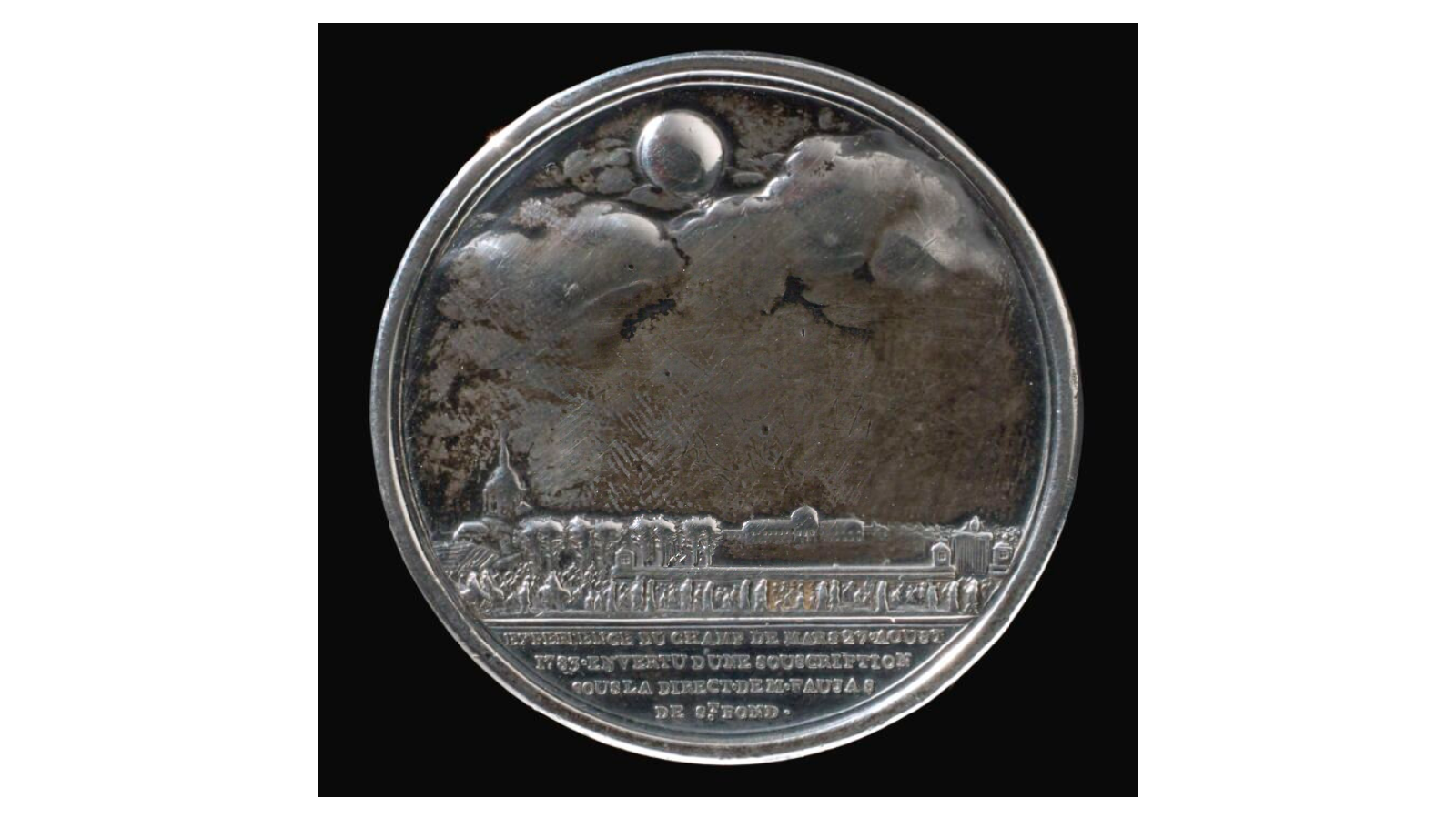
Reverse of medal. Held in the Science Museum.
The Mongolfiers thought it was the ‘coals’ “embers” or smoke that generated the lift. This was not corrected until Englishman James Sadler demonstrated it was the ‘hot air’ that was lighter than cold air and thus gave lift to the balloon.

First Public demonstration of Balloon. 4th June 1783.

USLC cards including First public demonstration in Annonay 4 June 1783 02562r
Cards of balloons.
England.
Here our speaker brought to our attention the activities of an Englishman James Sadler, who deduced the Montgolfier brothers were wrong in their understanding of the principle of lift as ‘the smoke’ but in reality the less dense hot air as hot air was ‘lighter’ than cold or ambient air. This was to the audience a most interesting unknown person and fact.
James Sadler.
Text from Wikipedia
https://en.wikipedia.org/wiki/James_Sadler_(balloonist)
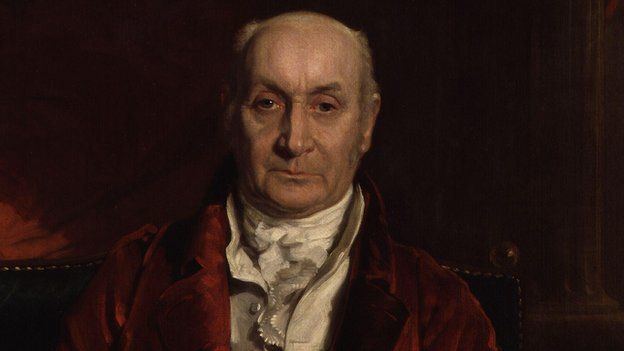
James Sadler balloonist
Sadler worked as a pastry chef in the family business, The Lemon Hall Refreshment House, a small shop in Oxford.
Sadler was the second person to make a balloon ascent in England, very soon after the Tuscan Vincent Lunardi's flight on 15 September 1784 in the grounds of the Honourable Artillery Company at Moorfields.
However, James Sadler was the first English Aeronaut having made his ascent during the month after on 4 October 1784 from Christ Church Meadow, Oxford. The balloon rose to about 3,600 feet and landed near Woodeaton, around six miles away. His second ascent on 12 November, this time in a hydrogen-filled balloon, reached Aylesbury in Buckinghamshire after a twenty-minute flight. In May of the following year he took off near Moulsey Hurst, Surrey, accompanied by W. Wyndham MP, hoping to reach France, but in fact descending in the Thames Estuary, and thus failing to repeat the earlier exploit of Jean-Pierre Blanchard and his passenger. Sadler made two further ascents in May 1785, the first of which was from a field behind a gentleman's garden on the site of what is now Balloon Street in Manchester. On this flight he was accompanied by a cat and landed in Radcliffe. On his second ascent he travelled alone and having risen to 13,000 ft. travelled 50 miles before landing near Pontefract, West Yorkshire. On this occasion, he sustained bad injuries after being dragged for around 2 miles by the balloon, which eventually threw him clear before taking off again empty.
He was appointed Chemist in 1796 in the newly created Naval Works Department under Sir Samuel Bentham. Although the post was only abolished in 1807, he had major disagreements with Bentham and carried out few works. His most important invention was that of the table steam engine. He was responsible for improvements to cannon design, from the barrel to the shot used, to improve accuracy; for which he was praised by Admiral Lord Nelson.
He resumed his ballooning activities although he was devastated by the death of his younger son, Windham Windham Sadler, in a ballooning accident in 1824.
He is buried at the church of St Peter-in-the-East in Oxford, now part of the college St Edmund Hall.
Legacy
Although a celebrity in his own time, Sadler is largely unknown today. This has been partly attributed to his lack of writing any works and partly to class prejudice: he was only a pastry chef and not formally educated. Despite being a resident of Oxford and an accomplished scientist, the university mostly ignored him and academics looked down on him. While obituaries for Sadler were written elsewhere on his death, the university's own newspaper wrote simply, "Mr James Sadler, elder brother of Mr Sadler of Rose Hill, Oxford, has died."
Manchester connection.
A public square in Manchester was named after Sadler on 8 September 2015 by NOMA, which is a neighbourhood being developed in partnership by The Co-operative Group and Hermes Investment Management. The square is named Sadler's Yard and is near to Balloon Street.
Link to BBC articles.
https://www.historyextra.com/period/georgian/james-sadler-from-pastry-cook-to-first-english-aeronaut/
https://www.bbc.co.uk/news/uk-england-oxfordshire-28094742
Montgolfier Brothers.
The well known balloon ascent and the many articles about this and the images and engravings has instilled in the public mind the Montgolfier brothers as the main characters in hot air ballooning.
Link:
https://www.britannica.com/biography/Montgolfier-brothers
British first “airship pilot”
Ernest Willows,
Called the Father of British Airships who was issued Airship Pilots Certificate No. 1.
Ernest Thompson Willows was born 11 July 1886, Cardiff, Wales, and died 3 August 1926.
Ernest Thompson Willows (1886–1926) was a pioneer Welsh aviator and airship builder. He became the first person in the United Kingdom to hold a pilots certificate for an airship when the Royal Aero Club awarded him Airship Pilots Certificate No. 1.
extract
https://en.wikipedia.org/wiki/Ernest_Willows

Willows No. 1
Built in 1905, Willows' first airship at age 19, offered some very unique features amongst airships of the day. Most notable is that it flew and was navigable! In addition to a 10 foot diameter, pusher propeller, the engine drove a pair of propellers in the front. These tractor propellers could be swivelled to direct their thrust and thus the ship could turn, ascend or descend without the use of rudders or elevators. The gas envelope of the No. 1 was 72 feet long, 18 feet in diameter, made of varnished silk (common among the early, small airships of the era), carrying a 30 foot long, triangular, steel-tube frame gondola.
He built his first airship, the Willows No. 1, in 1905 when he was 19. It was first flown from East Moors, Cardiff on 5 August 1905, the flight lasting 85 minutes. This was soon followed by an improved Willows No. 2, in which he landed outside Cardiff City Hall on 4 June 1910. No. 2 was re-built as No. 3 which he named the City of Cardiff before he flew it from London to Paris in 1910. This was the first airship crossing of the English Channel at night and the first from England to France. The journey was not without incident, including dropping the maps over the side during the night, and problems with the envelope caused the airship to land at Corbehem near Douai at two o'clock in the morning. With the help of the local French aviator Louis Breguet the airship was repaired and arrived at Paris on 28 December 1910. He celebrated New Year's Eve with a flight around the Eiffel Tower.
Willows moved to Birmingham to build his next airship, the Willows No. 4. First flown in 1912, it was sold to the Admiralty for £1,050 and it became His Majesty's Naval Airship No. 2.

His Majesty's Naval Airship No. 2 on the ground Ernest Willows airship.
His picture is on website.
http://cathayscemetery.coffeecup.com/earnestwillows.html
Charles Green.
Charles green was noted for using coal gas to replace hydrogen. A much less costly gas and quicker to fill a balloon.
Link and extract.
https://en.wikipedia.org/wiki/Charles_Green_(balloonist)
Charles Green (31 January 1785 – 26 March 1870) was the United Kingdom's most famous balloonist of the 19th century. He experimented with coal gas as a cheaper and more readily available alternative to hydrogen for lifting power. His first ascent was in a coal gas balloon on 19 July 1821. He became a professional balloonist and had made 200 ascents by 1835. In 1836, he set a major long distance record in the balloon Royal Vauxhall, flying overnight from Vauxhall Gardens in London to Weilburg, Duchy of Nassau (Germany) a distance of 480 miles (770 km). By the time he retired in 1852, he had flown in a balloon more than 500 times.

Henri Giffard.
He was notable for using a steam engine in his balloon. A steam power steering balloon. Steam was never used again.
Steerable flight. (“Dirigible”)
https://wunderkammertales.blogspot.com/2015/01/henri-giffard-and-his-steam-powered.html
A good photo of an early collectable card as an advertisement is on this site with Henri Giffard’s balloon.
A German collectible card, a so-called “Liebigbild”, added to product packaging of a meat extract
around 1900, showing Giffard on his flight.
Jules Henri Giffard, a French engineer and inventor. He built the first full-size airship — a cigar-shaped, non-rigid bag that was 143 feet (44 meters) long and had a capacity of 113,000 cubic feet (3,200 cubic meters). He also built a small 3-horsepower (2.2-kilowatt) steam engine to power a three-bladed propeller. The engine weighed 250 pounds (113 kilograms) and needed a 100-pound (45.4 kilograms) boiler to fire it.
The first flight of Giffard's steam-powered airship took place Sept. 24, 1852 — 51 years before the Wright Brothers’ first flight. Travelling at about 6 miles per hour (10 kilometres/hour), Giffard travelled almost 17 miles (27 kilometres) from the Paris racecourse to Elancourt, near Trappes. The small engine could not overcome the prevailing winds, and Giffard could only manage to turn the airship in slow circles. He did, however, prove that in calm conditions controlled flight was possible.
Santos-Dumont. A Brazilian in France.
France was the established place for airship technology and others came there to be involved at the centre of the developing industry.
Santos Dumont.
https://en.wikipedia.org/wiki/Alberto_Santos-Dumont
Alberto Santos-Dumont (20 July 1873 – 23 July 1932) was a Brazilian inventor and aviation pioneer, one of the very few people to have contributed significantly to the development of both lighter-than-air and heavier-than-air aircraft.
Santos Dumont WikipediaCommons photo "14 bis".
The heir of a wealthy family of coffee producers, Santos-Dumont dedicated himself to aeronautical study and experimentation in Paris, where he spent most of his adult life. In his early career he designed, built, and flew hot air balloons and early dirigibles, culminating in his winning the Deutsch de la Meurthe prize on 19 October 1901 for a flight that rounded the Eiffel Tower.
Good article in link:
http://www.smithsonianeducation.org/scitech/impacto/graphic/aviation/alberto.html
He was involved in both 'lighter-than-air' machines and 'heavier-than-air' machines.
Santos Dumont was also the first to fly a “Heavier-Than-Air Machine” in Europe in 1906.
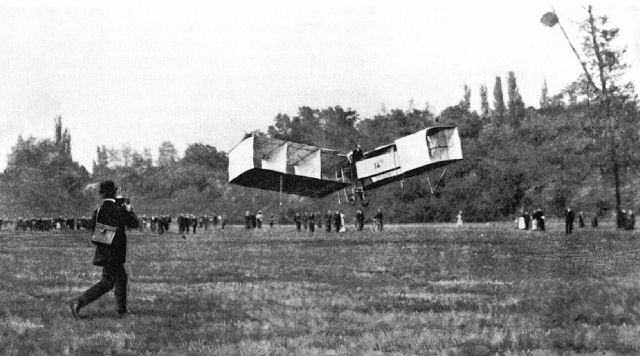
Photo of his “14 bis” engine powered flight.
http://www.dominiopublico.gov.br/pesquisa/DetalheObraForm.do?select_action=&co_obra=17641
Spencer
Stanley Spencer
Stanley Edward Spencer (1868–1906) was an early English aeronaut, famous for ballooning and parachuting in several countries, and later for building and flying an airship over London in 1902
https://en.wikipedia.org/wiki/Stanley_Spencer_(aeronaut)

Photograph in the German boulevard magazine Die Woche showing "Luftschiffer Stanley Spencer mit Familie" (Aeronaut Stanley Spencer with family).

Spencer designed "Mellins Airship" advertising airship.
British airships.
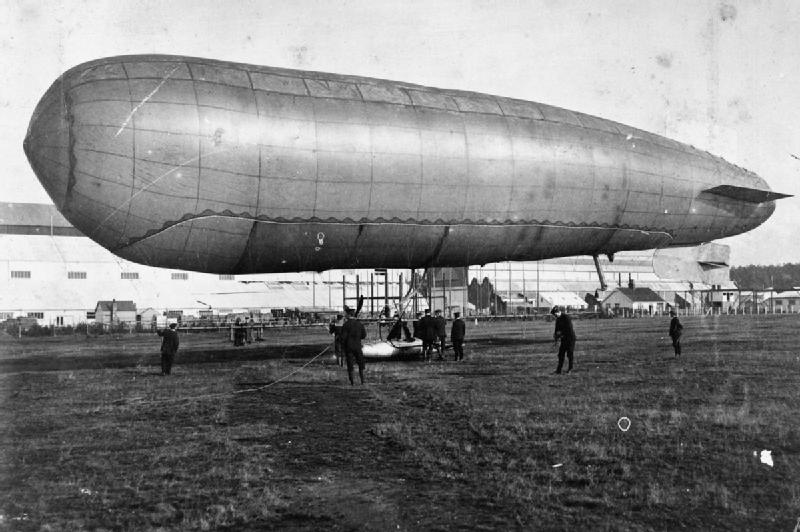
Aviation in Britain Before the First World War RAE O755.By Royal Engineers

Five British Army Airships the Nulli Secundus Dirigible No 2 the Beta the Baby and the Gamma RAE O104
The German developments.
Prior to the first world war, the German forces had developed on the previous ideas and built airships.
As did other forces as spotter platforms for observation and fire control.
Britain had discounted Airship Raids as ‘they flew during the day’ They were large and could be seen’ and thus easy targets.
The Germans proved the British wrong. Zeppelins flew at night, and were very difficult to shoot down as they flew at heights which took a fighter plane about 40 minutes or more to get to that height and the ammunition did not set the Zeppelins on fire, and as they had many ‘gas bags’ the lost of one or more was a mere inconvenience.
Eventually a crisis developed in the UK as ‘air raids’ became an actual event.
Here London was saved much damage as The Kaiser kept back the Germans from bombing UK for a couple of years or so. Specifically London where there were his cousins and fellow monarch, a later example of how the British at Waterloo did not shell Napoleon because Wellington said “we do not shell generals”, when asked for permission to fire on Napoleon.
Guided Airships.
Zeppelin’s developments were due to his research on the topic of "Lenkbare Luftschiffe" or "guidable airships", with rigid structural shape to with stand the forces during flight.
See link:
Article on Zeppelin.
http://www.century-of-flight.net/Aviation%20history/coming%20of%20age/zeppelin.htm
Graf von Zeppelin
Article: on warfare.
With a comic style illustrations and story. History rendered into internet art.
Zeppelin, Count Ferdinand Graf Von Zeppelin
"On the night of January 19, 1915 two German navy Zeppelins carried out the first successful bombing run against British soil. One of the ships was the L-3. Both craft bombed from an altitude of 3,000 feet and both returned safely. On May 31, 1915, ten months into the war, the first Zeppelins showed up over London. In August 1916 two-million cubic feet mid-level ships operating at 13,000 feet went on line. It wasn't until September 2, 1916 that the British pulled the first airship out of the sky over England in direct air-to-air combat"
link:
http://the-wanderling.com/zeppelin.html
Zeppelin. Brief story of his life.
Extract from: https://www.firstworldwar.com/bio/zeppelin.htm
Count Ferdinand von Zeppelin (1838-1917) was born in Konstanz, Baden on 8 April 1838 and was the first large-scale builder of the rigid dirigibles which eventually became synonymous with his name.
USA service of Count Zeppelin.

German USA War students of two continents by Alexander Gardner 1863 (with von Zeppelin).
Count von Zeppelin's military career was somewhat varied. During a leave of absence from the Prussian army in 1863 he served with the Union army during the U.S. Civil War. More conventionally he served with the Prussian army in the Austro-Prussian War of 1866, and the Franco-Prussian War of 1870-71, during which he was commended for bravery.
He married, in 1869, to Isaballa Freiin von Wolff from Livonia; they had a daughter, Hella, born in Ulm in 1879.
His own fortune was put behind his ideas as he funded the research from his own money.
Zeppelin first conducted balloon trials whilst in the U.S. as a military observer during the 1860s. He subsequently founded an airship factory at Friedrichshafen using his own funds, retiring from the army in 1891 with the position of lieutenant-general. Zeppelin proceeded to devote the remainder of his life to the design and construction of engine-powered dirigibles.
The first successful trial of one of his airships took place on 2 July 1900. Eight years later Zeppelins were making routine commercial mail and passenger flights over Germany, with a remarkable safety record despite the risks in using highly flammable hydrogen gas to inflate the airships.
Zeppelin successfully persuaded the German military of the potential of using airships during wartime. Consequently Zeppelin's LZ-3 model was accepted into German army service in March 1909 as the Zeppelin Luftschiff 1. In the event, during the First World War, the German military deployed 115 Zeppelins for a variety of missions including reconnaissance and bombing, despite their vulnerability to attack and bad weather.
Zeppelin aircraft were effectively removed from front line service at Verdun in 1916, as improved Allied aircraft succeeded in achieving a higher destruction rate. Even so, newer models were introduced that could fly higher and higher, although this impacted their bombing accuracy. Their use was more or less discontinued in 1917 as Allied bombers demonstrated a consistent ability to destroy the airships.
Ferdinand von Zeppelin died on 8 March 1917 in Berlin.

German Dirigible Flying Over the British Fleet.

German Bull George Hotel Ramsgate Kent England German Zeppelin raid damage 1915.
British Airships.
Link:
https://en.wikipedia.org/wiki/List_of_British_airships
Extract summary.
Airship development in the United Kingdom lagged behind that of Germany and France. The first British designed and built airship was constructed by Stanley Spencer, and on 22 September 1902 was flown 30 miles (48 km) from Crystal Palace, London to Ruislip, carrying an advertisement for baby food. A series of more practical airships was constructed by Ernest Willows, the "Willows Number 1" making its first flight near Cardiff on 5 August 1905. The Royal Navy realised that airships similar to Ferdinand von Zeppelin's designs could be of great use and in 1909 ordered construction of a rigid airship. This was completed in 1911 but was wrecked while leaving the hangar before it had flown. Meanwhile, the British Army's School of Ballooning, later the Air Battalion Royal Engineers, acquired a small fleet of semi-rigid and non-rigid airships for observation purposes; they were taken over by the Royal Navy on the creation of the Royal Naval Air Service in 1914. A large number of rigid and non-rigid airships were mainly used to counter the U-Boat campaign in World War I. Interest in military airships declined at the end of the war, but some success in the commercial field inspired the Imperial Airship Scheme; however, the disastrous crash of the R101 in 1930 ended serious government and commercial interest in airships.
Since the 1970s, there have been persistent efforts to revive a British airship industry, using new designs, materials and technologies.
Page with notes on raids on Britain and counter offences.
extract.
First Zeppelin casualty over UK.
Lieutenant Leefe Robinson, of No 39 Squadron, proved this theory wrong when on 2 September 1916 he took off from Suttons Farm, near Hornchurch and shot down with incendiary and explosive ammunition SL11, a Schütte-Lanz airship (principally of wooden structure, unlike the metal framed Zeppelins). SL11 crashed at Cuffley in Hertfordshire and Robinson was awarded the Victoria Cross.
By 1917 the strength of the Home Defence (HD) units stood at twelve squadrons, mostly operating from airfields with at least some night flying facilities. After a three month gap, a 5 airship raid on London was launched on the night of 16/17 March 1917. The attack proved ineffective due to bad weather. The same was true for three further raids during the summer of 1917.
The final Zeppelin bombing attack on England took place on the night of 5/6 August 1918 with 5 airships taking part. Once again bad weather was a factor in the effectiveness of the raid. None crossed the English coast and L70, Germany’s newest Zeppelin, was shot down by a DH 4 off Wells-next-the-Sea, Norfolk.
Such was the end of the Zeppelin raids.
Accidents and casualties.
There were many lives lost during the period of early development, and accidents in flight.
As in the development of most transport systems, there were many early casualties through accident or mismanagement.
The future of development of travel depends on pioneers taking acceptable risks.
Thanks.
The members and visitors thank Dave Bushby for a most enjoyable talk, which has shown us facts and events we did not have in our general knowledge.
- Details
- Category: Reports
Muckers on the Wire
Warrington Soldiers in World War 1
A brilliant and well received talk by Nigel Wilkinson was given on November 8th, 2018 to our Group on the first few months of the 1914 -1918 war.
The illustrations were from Nigel Wilkinson's book, "Muckers on the wire" and illustrated the lives, hopes, disappointment and horrible realities of these first few months of the war experienced by soldiers from Warrington.
They were part from the existingTerritorial Army (originally raised and intended only to fight within the UK) and the subsequent recruitment of soldiers from the local Warrington and surrounding area factories and industries.

Nigel Wilkinson from a Warrington Guardian photo report when the book was published.

Part of the cover of Nigel Wilkinson's book.
The illustrations given during the talk were superbly researched to illustrate his talk.
The South Lancashire Regiment.
Extract from records.
Regular Army
The 1st Battalion spent the war on garrison duty in Quetta, Baluchistan, on the North-West Frontier. The 2nd Battalion landed at Le Havre as part of the 7th Brigade in the 3rd Division in August 1914 and spent the entire war on the Western Front. The 3rd (Reserve) Battalion was a depot and training battalion stationed in Lancashire throughout the war.
Territorial Force
The 1/4th Battalion landed at Le Havre as part of the 7th Brigade in the 3rd Division in February 1915 for service on the Western Front. The 1/5th Battalion landed at Le Havre as part of the 12th Brigade in the 4th Division in February 1915 also for service on the Western Front.
Finish of extract.
Territorial service.
The Territorial force included the 'Warrington Soldiers" were raised as Territorial Soldiers who obtained an experience different from their factory life, and the obligation of the two weeks camp was seen as a 'paid holiday' by many Territorial Soldiers. It was a considerable attraction at the time before the First World war, when paid holidays were not normal. Often the TA group would be personnel from a specific factory with the owner funding the group from personal wealth, and perhaps being a nominated head of the unit. The men having to pay for their own equipment and training ammunition for their rifles.
They were volunteers obliged to attend a drill hall on their off-work-day (Saturdays) for about twenty days per year and also attend a two week camp each year. (This time obligation was still the same in the 1950s.) The camp as a paid holiday in a distant area was a big attraction to young men in pre-1914 industrial towns and the owners of factories and works ‘competed’ to provide a ‘show force’ for status funded partly by their own funds.
It was originally seen as a last defence in the country against an invasion to supplement the home stationed regular army; where most regiments had battalions that rotated between home and foreign service on a 3 year tour basis, so always there was less than 50% of the regular army in the UK.
It differed little from the “Fyrd” of Saxon times:
Quote
A Fyrd was a type of early Anglo-Saxon army that was mobilised from freemen to defend their shire, or from selected representatives to join a royal expedition. Service in the Fyrd was usually of short duration and participants were expected to provide their own arms and provisions.
Unquote
The Territorial Army was funded and equipped much like a Saxon era local Fyrd, namely it was raised locally for part time service with soldiers intended to provide and pay for part of their own kit, such as boots, and training ammunition (so not much actual shooting practice or musket drill was done).

Typical camp 1913 some in uniform some in work clothes 5th Border Regiment
The government of the day was trying to get a reserve force for little cost. Little had changed since Saxon times.
War.
Then came the declaration of war in 1914, and the local Warrington ‘Saturday Warriors’ who were then on their annual camp were summoned for active duty.
Political changes to obligations.
As the force could not be legally sent abroad, and the government needed them in Belgium & France as Germany’s plan to sweep to Paris in a short time had only been stopped just short of Paris.
At which point the German commanders picked their line of defence/offence and retreated to the higher ground where they had superiority of ‘field of fire’ down on any opponent. A set of battles (the race to the sea) eventually set an almost fixed line, from the Swiss border to the sea on the coast of Belgium, with the Germans on the high ground.
“We agree to serve abroad” [or so reported!]
A meeting was held in The Parr Hall of the local TA soldiers to try to obtain a concession from them to volunteer for foreign service. It was reported as successful in the papers [1 below] but our speaker has unearthed from diaries of the commanding officer [2 below] that he did not think the change would happen. A lot of persuasion including agreement to pay some compensation and hold jobs open for their return from the war was agreed.
1. The papers: “the 4th battalion agreed almost to a man to offer themselves for foreign service.”
2. The diary: ‘The Battalion did not unanimously agree, in fact on the first meeting only about 45% held up their hands’..... could anyone have expected them all to go in those early days?’
The slides showing newspaper report and the actual officer’s recording of events had a big impact with our listeners.
The result was the battalion went to war. Entraining at Bank Quay Station, Warrington aftet an early start a long wait for a train.

Entraining, the long wait for a train. Lancashire -infantry-museum_photo_waiting_to_entrain_index.jpeg.
A Lancashire Infantry Museum photo. Regiment waits for transport [they went to Scotland!]
They were allocated to defend Rosyth on the Firth of Forth, as enemy submarines were expected in the Firth.
Within weeks, they had altered duties and entrained for France and Flanders where they became part of the soldiers around Ypres.
The Ypres Salient was the main head of rail for supplies from UK and channel ports to the front line.


Ypres November 1914 (Imperial War Museum photo)

November 1915 Ypres Market Square shows the destruction by German Artilery from their higher ground bases.
Ypres by 2015. The town destroyed by enemy shelling from their higher positions.
Allied Soldiers from Warrington were in static lines in shallow wet trenches.

Instructions for a shallow trench with higher built up protection above soil level.
The instructions.
An 'idealised' reconstruction at Ypres exhibitions. Reconstruction of shallow trench with sandbag top Ypres 003
“Fancy” Reconstruction in Ypres tourist area of how it should have been, but the upper walls were often full of dead bodies used as ‘bricks’.

The reality of trenches in the wet soil around Ypres.
(Trenches should not be deep as water level was just below the surface in Ypres).

Over the top to attack. (Image from Somme battle).
Going over the top the Warrington soldiers were in full line of fire from the upper positions of the German trenches, so attach was to walk into a hail of bullets and other weapons.

South Lancs infantry Museum Photo .
In the field lay the dead, at least for a day as recovery could only be done in darkness, and in some cases for many months before the dead could be recovered for burial.
Strange An odd point, opposite the Warrington soldiers later in war a specific German was stationed.
QUOTE
24th October 2014. From website: http://ww1blog.osborneink.com/?p=2381

A named foe was known to be opposite the Warrington trenches.
Above: the church at Zonnebeck sometime in 1915-1917. Yesterday, (23rd October 2014) a private in the 16th Bavarian Reserve Regiment named Adolf Hitler de-trained at the occupied French city of Lille, where Crown Prince Rupprecht commands the German 6th Army. Today he is marching towards the Ypres salient.
This became relevant during negotiations for peace before the Second War with Hitler, when he asked where a UK person from Warrington in the UK delegartion was stationed during the Great War.
Sometimes the link is in little things.

A later image of the church.
The speaker's talk.
The talk covered the early part of the engagements of Warrington soldiers, 2014-2015, and the summary of events is given on another’s presentation quoted below.
CLHG: From presentation of another person on Ypres 2014-2018 a summary.
https://www.slideserve.com/havily/battle-of-ypres
Quote
-
Race to the sea: German vs. Allied Forces as they all try to secure N. France’s ports
-
Germany uses the German Fourth Army, aka Kinder Corps (kinder = children) - majority of soldiers = young, inexperienced volunteers between ages 17-19
-
Sub-battles (Langemarck, Gheluvelt, Nonnebosschen) = heavy losses for Germans, less for British/Allies
-
Encountered well-trained British Expeditionary Force
-
Allied (France, UK, Belgium) victory
-
Everyone wanted Hill 60
-
Strategic geographical position—overlooked Ypres / all the roads around it
-
British take initially take Hill 60
-
Taken by Germans during First Battle of Ypres
-
Both sides accuse the other of using gas attacks
-
Finally retaken by Allies in 1918
-
The British took advantage of the winter season for warfare.
-
Massive German offensive attack
-
There were two new forms of warfare:
Chlorine Gas: Signalled the beginning
Flamethrowers: “Liquid Fire” -
British/Canadians held the line against Germans,
despite gas attacks
-
Essentially a stalemate
-
Main players: French/British Empire, Belgium vs. German Empire
UNQUOTE

From local industry to 'Muckers' the Joseph Crossfield works memorial. A pals memorial.

The Warrington town memorial.
And still nightly they play a bugle call at:

The Menin Gate at Ypres / Ieper, Flanders, Belgium
Please, visit the website below, read details, and listen to the ceremony.
http://www.greatwar.co.uk/events/menin-gate-last-post-ceremony.htm
The 30,000th ceremony is available through a browser on Google’s YouTube video at:
https://www.youtube.com/watch?v=yV6Oo3Y_pf8
Ceremony of the 30,000th. Last Post in Ypres ( 9 july 2015 )
Writer’s note:
Images are from Imperial War Museum or other public domains. All copyrights acknowleded where known
The speaker’s images are in his book, and not in this article. They are well worth the effort to obtain and read.
Thanks
The group thanks Nigel Wilkinson for his most impressive talk and enlightenment of our members and visitors.
- Details
- Category: Reports
20181011 Knutsford Hoard
Photographs are from Liverpool ECHO, The British Museum by permission (a typical pot), and the Liverpool Museums articles on the finds. All copyrights acknowledged.
On Thursday 11th October 2018, 26 members and 3 visitors were treated to a talk by Vanessa Oakden, the current Curator of Regional and Community Archaeology at Liverpool Museums about The Knutsford Hoard found by a metal detectorist who reported it to Vanessa Oakden in her former role for Liverpool Museums as Finds Liaison Officer. A ‘Finds liaison Officer’ is based at a museum and co-ordinates with and enters the reported finds into the Portable Antiquities Database after verifying that the find is suitable for entry to the database.
The Portable Antiquities Scheme is run by the British Museum and National Museum Wales to encourage the recording of archaeological objects found by members of the public in England and Wales.
The metal detectorist Mr Alan Bates found the items in 2012. First a couple of items. Then more then he rang Vanessa Oakden saying he had ‘found a hoard’, Vanessa disbelieved, as she had been given many false reports before, but excitement was generated as she asked questions and established that this Mr Bates knew his coins and could describe them accurately.
So out of the comfy office into the field and review the finds and establish what was there and if worth further investigation after of course getting the formal permission of the landowner to look at the area (a permission Alan Bates already had).

Alan Bates and Vanessa Oakden at site with a new find
Excavation (with site owner's machinery help).
Excavations then were organised using the metal detectorist’s skill to mark suitable areas as the items had been scatted from ploughing. As she was pregnant, excavating was not the easiest thing. She remembered the discomfort and the excitement. Our audience were in awe at her dedication to such uncomfortable field work.

Coin being ecavated from ground showing muddy and wet conditions.
The result was “The Knutsford Hoard” found in 2012 by Alan Bates including three fine examples of gilt ‘trumpet’ brooches, two silver finger rings, and 103 coins which were issued between 32BC to the late 2nd century AD

The Liverpool Museum's page top photo of the hoard. Showing a ring, coins and broach
The preparation of the display.
Of course the biggest work is the cleaning, recording, and eventually getting the finds established as treasure under the Treasure Act. The metal detectorist and the archaeologists have to understand a great deal of complex law, (the “Gov.UK” website shows a 135 page PDF ‘summary’ as its code of practice) with regard to the finds, but a useful summary given below was abridged by Vanessa for our easy understanding “two or more coins or objects with more than 10% gold or silver over 300 years old”. The advice to metal detectorists on treasure is given below in the paragraph headed “Summary: Treasure Act."
Aquisirtion announcement in the museum's blog.
Announcement in Museum Blog.
https://blog.liverpoolmuseums.org.uk/2015/07/treasure-acquired-for-the-region/
The Clasp-Broaches
These 3 ‘trumpet’ style broaches are shown below, and also a modern cheap one (sold by internet) and one very expensive modern Danish version, so their use has lasted over many years with our population to hold cloaks or other garments

Photos of the old hoard broaches.
and photos of new modern equivalents still in use:


An expensive modern Danish pin clasp cloak broach . Modern bling equals the roman bling.
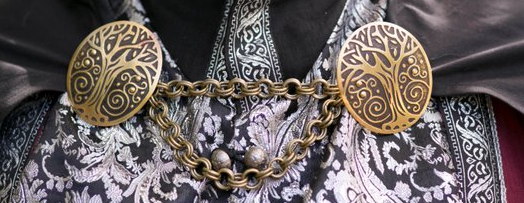
How two broach clasps and chain hold on a cloak, modern use in Denmark.
The Rings.
The two rings are shown, one with its decoration intact save for wear, and the other with the stone smoothed.
One has had the ring diameter adjusted (perhaps to re-use it for a second person).

The decorative engraved stone ring.
The smooth stone set ring.
The Coins.
There were silver ones and a small amount of copper ones. It is assumed the copper ones were placed at the top to form a top layer to protect or seal in the lower more valuable ones and the other objects in the pot, like a paper cover top in a jar of home made jam.
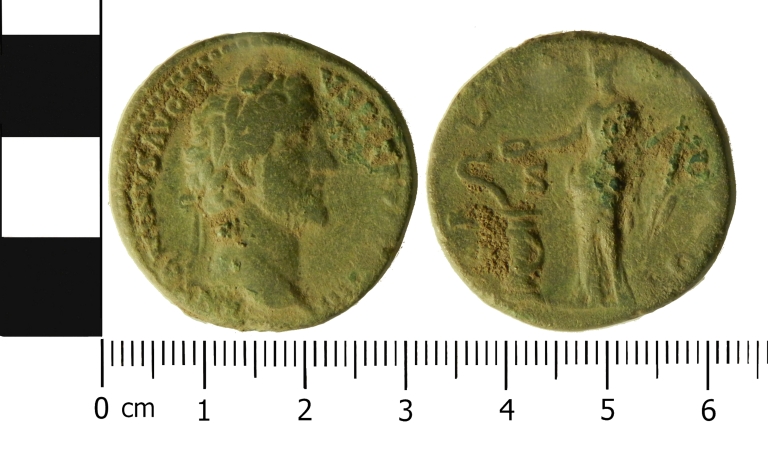
The copper coins. Copper_alloy-sestertius_of_Antoninus_Pius.
Photo of the probable seal or top layer copper coins.

Not all the coins had 'macho emperors' on them. This shows Silver_denarius_of_Lucilla-and_Venus-standing-to-left_holding_victory_Liverpoolmuseums-photo
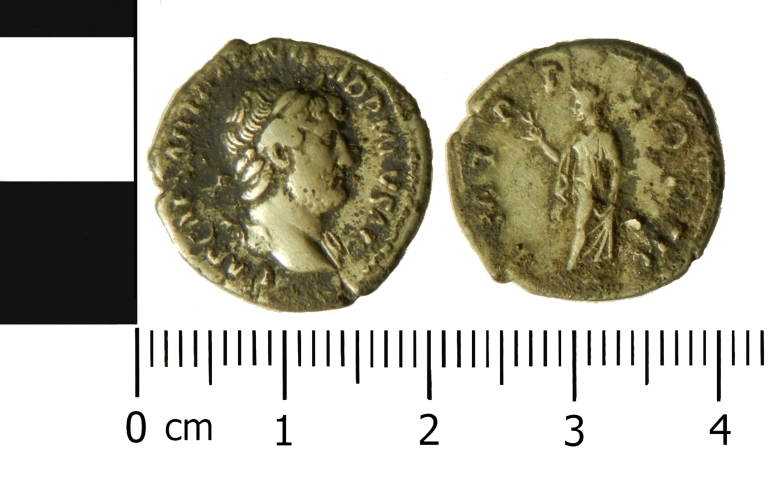
Uk's best known emperor, some Scots like his idea of a wall . A silver-denarius-Hadrian-liverpoolmuseums--photo.

The playwright's and cinema's emperor. A silver-denarius-mark-antony-Liverpoolmuseums-photo
The Containing Vessel.

The-piggy-bank-pot_-pieces-of-orange-ware-pot_Liverpoolmuseums-photo

Typical pot from British Museum's collection. Was the Knutsford pot like this? BritishMuseum-typical-Roman-pot_360126001.jpg
The broken container with the ‘copper top’.
From the ceramic shards found at the site it is assumed that the hoard was in a ‘jar’ /‘cup’ / ‘vase’ with the top layer being the few copper coins which were used as a ‘lid’. The rim of the vessel was not found, and the shards were scatted across the area due to ploughing.
A very old ‘piggy bank’ with the silver and gold beneath the top copper coin layer.
If the container is of lead, the coins are in much better condition than if in a ceramic jar, due to chemical interactions of lead and the precious metals.
Typical container photo by permission of The British Museum (not the one of the Knutsford hoard as it is shattered.
The rim of the Knutsford Hoard pot has still not been found, only a few shards.)
Links: for your better viewing and understanding of the finds.
The best photographs of all the items and a history of the finding and cataloguing is given on The Museum of Liverpool’s website and in the “finds” websites.
We do earnestly recommend a visit to these sites to understand all the items.
Museum link.
http://www.liverpoolmuseums.org.uk/mol/collections/archaeology/cheshire/knutsford/index.aspx
Finds link.
https://finds.org.uk/treasure
Summary: Trasure Act
Summary: Treasure Act. Given on ‘detecting.org.uk’ website.
http://www.detecting.org.uk/html/Metal_Detectors_The_Treasure_Act.html
The Treasure Act
The Treasure Act, 1996 is a piece of legislation designed to deal with finds of treasure primarily those made by metal detectorists in England and Wales. It legally obliges finders of objects which constitute a legally defined term of treasure to report their find to their local coroner within fourteen days. An inquiry led by the coroner then determines whether the find constitutes treasure or not. If is declared to be treasure then the owner must offer the item for sale to a museum at a price set by an independent board of antiquities experts. Only if no museum expresses an interest in the item or is unable to purchase it can the owner retain it.
'Treasure' is defined as being:
All coins from the same hoard. A hoard is defined as two or more coins, as long as they are at least 300 years old when found. If they contain less than 10% gold or silver there must be at least 10 in the hoard for it to qualify.
Two or more prehistoric base metal objects in association with one another
Any individual (non-coin) find that is at least 300 years old and contains at least 10% gold or silver.
Associated finds: any object of any material found in the same place as (or which had previously been together with) another object which is deemed treasure.
Objects substantially made from gold or silver but are less than 300 years old, that have been deliberately hidden with the intention of recovery and whose owners or heirs are unknown.
Under English law a landowner has sole title to any archaeological artefacts found on his or her property. Legitimate metal detectorists come to an agreement the owners of the land they detect on to share any proceeds from treasure sales. Those who detect illegally, either on Scheduled sites or without the landowners' permission cannot benefit from the Treasure Act.
Illegal detectorists have had their loot confiscated and can face fines and prison.
End of summary.
Metal Detectorists and how their hobby enriches the U.K.
The value of metal detectorists to UK history.
In 2014 the BBC had an article and program on the finds from 2012, as it takes a long time to get all items organised, cleaned and recorded. They said:
Amateur archaeologists with metal detectors found 990 items classified as treasure during 2012, according to figures from the British Museum. All of the rare coins, rings and brooches contain gold or silver, and many date back more than 1,200 years.
The public reported more than 74,000 other historical items to the Portable Antiquities Scheme, which experts say has "revolutionised archaeology". More than 900,000 objects have been reported since it started in 1997.
Neil MacGregor, Director of the British Museum said the scheme, which launched its annual report today, was "ensuring that finds found by ordinary members of the public are rewriting history."
"Many of the most important finds have ended up in museum collections across the country, thanks to the generosity of funding bodies," added MacGregor, who launched the report with culture minister Ed Vaizey.
A total of 8,500 archaeological items have been classified as treasure, which signifies the presence of a precious metal, such as gold or silver according to figures from the British Museum.

Image from Liverpool Echo of Alan Bates and theKnutsford Hoard JS82759983
Thanks.
The members and visitors thanked Vanessa Oakden for her talk and some hope to inspect the hoard at her invitation at Congleton Museum where it is currently on display.
Link to Congleton Museum.
https://www.congletonmuseum.co.uk/
Link to Liverpool Museum
http://www.liverpoolmuseums.org.uk/mol/collections/archaeology/cheshire/knutsford/index.aspx
Link to metal detectorists' forum UK
https://www.metaldetectingforum.co.uk/
Link to Current Archaeology Magazine UK
Current Archaeology is a British monthly archaeology magazine.
https://www.archaeology.co.uk/
- Details
- Category: Reports
20180508 A talk on "The Bollin Valley, Dunham to Warburton" by Keith Warrender.
On Thursday May 8th, 2018, the members and guests were given a superb display of photographic views with historic and anecdotal notes of buildings, and sites, with historic and anecdotal notes in the Bollin river valley between Dunham and Warburton taken by our speaker Mr Keith Warender, a former graphic designer.
The photographs below are all CC by SA licence from public domain sources and not from the speaker.
Fire.
Quote
"BOLLINGTON, a township partly in the parish of BOWDON, but chiefly in the parish of ROSTHERN, hundred of BUCKLOW, county palatine of CHESTER, 5½ miles (N. by W.) from Nether Kuutsford, containing 264 inhabitants. There is a place of worship for Wesleyan Methodists." [From Samuel Lewis A Topographical Dictionary of England (1831) ©Mel Lockie]"
Unquote.
We learned that "Little Bollington" was originally called "Bollington" as above and due to a fire and the fire service going to the wrong place, in recent years, the place where the fire took place but was not given help during the fire was renamed "Little Bollington" in 1981.
The distance of the error is shown below. (From Google Maps)

The Swan with two nicks.

A view of the pub. near Little Bollington, with its unusual name coming from ownership marks cut into the swan's beak.
The troubles of a photographer.
Our speaker took a day to try to get the tourist boat passing the outfall of the Bollin river into the Ship Canal, and being 'chased off' his parking spot thought he had lost "the shot" as the time when the boat would pass the Bollin point from timetables and estimated boat speed had passed, but as boats can be slow, he got his beatiful shot of the boat shown below just passing the confuence at Bollin Point.
Features of houses normally inaccessible to the public were shown and a lot of admiration for his persistence (?) to get photographs was admired.
The Boat
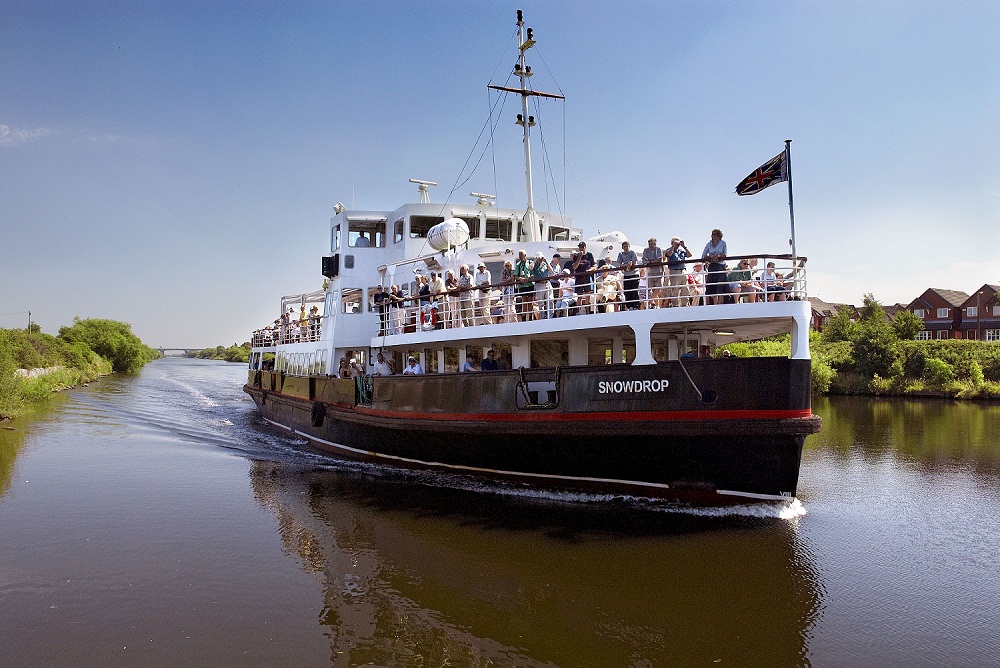
Bollin Point.

Bollin Catchment area.

The Toll Booth at Warburton.
Current Day History.
On the night before our talk, some "persons" had attached and set fire to the Toll Booth at Warburton, and by the time our speaker had passed the road was open. As our locals know the 'toll' is not paid for the high level bridge over the ship canal but for the old (now dry) former Mersey channel, as shown on the diagram below. On the next day the remains of the (private) toll booth were removed for safety's sake, with intention to later replace it.

Photos of points in the Bollin Valley.
After viewing the speaker's grand set of photographs of the Bollin Valley from Dunham to the Ship Canal, some felt we should have also have had a small talk about how to get very high quality photographs of views and buildings, as his expertise was visible in the slides shown to us.

Aquaduct carrying Bridgewater canal over Bollin from riv

Bollin goes under Manchester Airport geograph 90493 by Ian Warburton

Fish Ladder HEP scheme geograph 4157912 by David Dixon

Bridge in Lower Garden Quarry Bank Mill geograph 2858538 by David Dixon

Downstream near Morley River Bollin geograph 2858716 by David Dixon

The Enemy! Giant Hog Weed Heatley geograph 1386650 by david newton
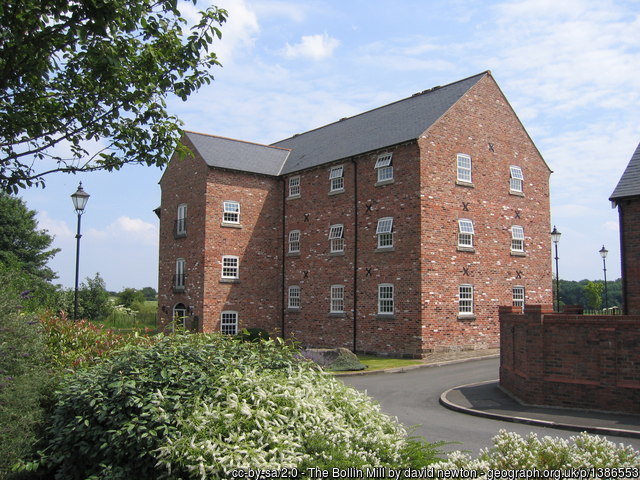
Old Mill new apartments Bollin Mill geograph 1386553 by david newton.
The old industry of the river becomes the new living places.
Books
The speaker has published his photography in a couple of books about the Bollin valley obtainable from the speaker at his address:
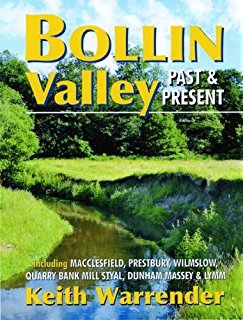
Bollin Valley past present 51UWuO8BYZL. AC UL320 SR244320

Bollin Valley Mac Ship 61Ho9XOMTVL. SX377 BO1204203200
Publisher: (Mr Keith Warrender's own firm).
Willow Publishing
Address: 36 Moss La, Altrincham WA15 6SZ
Phone: 0161 980 2633
Thanks.
Our thanks to our speaker for a most beautiful set of illustrations o fthe Bollin River Valley and its features.
- Details
- Category: Reports
20180412 CLHG Report. Two men, George Lyon and Charles Walmsley DRAFT.1.0
George Lyon and Charles Walmsley
On Thursday 12th of April 2018 our members (one of whom is a possible descendant of George Lyon) and visitors were taken by Marianne Howell through a well illustrated and researched talk into a different time and social structure with the tale of George Lyon "called the Upholland Highwayman" and Charles Walmsley the Lord of the Manor of Ince in Makerfield, Wigan.
The talk gave the details of the known facts about George Lyon including the item that for the main robbery of Charles Walmsley's house he sat outside while directing others to do the robbery. Not quite the 'bold robber' he claimed and boasted to be.
It appears George Lyon 'enriched' his tale when he told it to his local fellows and some details such as 'his transportation" are not documented and appear to have no basis from known records. He must have been tolerated as a known local thief and as such there may be a basis for his supposed help to others.
The (in)visible thief.
As retold in Wikipedia George Lyon's one major feat as a highwayman was to hold up the Liverpool mail coach. With his accomplices, who have been unknown since, he planned the robbery at the Legs of Man public house in Wigan. They then persuaded the ostler at the Bull's Head Inn in Upholland to lend them horses for a few hours. They held up the Liverpool mail coach at nearby Tawd Vale on the River Tawd, firing two shots and forcing the driver to pull up so that they could rob the passengers. The gang then returned to the Bull's Head, and when the robbed coach later arrived at the inn, Lyon and his accomplices had an alibi as people had seen them in the pub earlier in the afternoon.
George Lyon is said to have held up the Liverpool mail coach by firing shots and forcing the driver to stop. Then, having robbed the travellers, he went swiftly to the pub at Upholland, where he had been drinking earlier. The travellers arrived a little later, bringing with them their tale of robbery and their narrow escape from death, and as Lyon was in the pub both before the robbery and afterwards he was not suspected by the travellers.
The robbery at Ince.
One of George Lyon's accomplices an Edward Ford had been employed redecorating the manor at Ince and as such knew the lay out and what loot could be obtained when the owner and family were absent and only the 'live in staff' were at the house.
George Lyon and his three accomplices Edward Ford, David Bennett and William Houghton, carried out the burglary at Westwood Hall, Ince, Wigan in April 1815. Lyon was the 'lookout' who stayed outside, and even is said to have sent one of the others back to try to get more loot, which was in the form of silver items.
The loot was offered for sale in an inn but was both easily recognised and was bought by an undercover fence, thus informing the authorities and allowing the thieves to be caught and tried.
One of the thieves Ford, who it is thought had suggested robbing the house to Lyon, and had himself taken part in some 17 previous robberies, gave evidence against the others and was thus spared the death sentence given to the other three robbers.
A reproduction of George Lyon's letter (with the aid of the prison chaplain, the Reverend Cowley) to his family at Upholland to send him his suit and boots to wear at his execution was shown and in it the appeal to have his body brought back to Upholland for burial.
Trial and King's evidence.

We can surmise the prisoners would arrive to a similar crowd as above after sentence.
The four thieves were tried and sentenced. Edward Ford who it is thought had suggested robbing the house to Lyon, and had himself taken part in some 17 previous robberies, but because he turned King's evidence he was spared the capital sentence.
The execution of Lyon, Houghton, and Bennett, took place in Lancaster before a large crown, entertainment for the onlookers somewhat like a horse race meeting today, just before noon on Saturday 22 April 1815 for the offence of the burglary at Westwood Hall, Ince, Wigan.
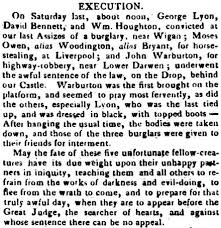

The return of the body to Upholland.
A publican and others carried out George Lyon's wishes to remove the body to Upholland and avoid a possible use of the body for dissection as was the then practice for executed persons. The trip was undertaken in very bad weather and our speaker illustrated the use of the available then and now maps to show the extra miles taken possible y to avoid a flooded stretch of road. The body return party being followed by many folk, so even at that time George Lyon was a 'celebrity' in his own district.
His body was buried in the same place as his recently deceased daughter and the gravestone shows her name but not his. Still at the present time this grave is visited by visitors to Upholland which makes it an unusual present day tourist attraction.


Unremarked old grave. Howver sometimes ... someone remembsrs and places a rose!


The church at Upholland, and an old photo of graveyard, looking to the inn with the grave in middle right of view. the right hand side building reputably haunted.
Note on the gravesite.
Below the level of the roadway, on the extreme western edge of the church burial ground and directly opposite the White Lion Hotel, lies a flat tombstone, with the single name
'Nanny Lyon' inscribed on its surface. This is believed to be the grave of George Lyon, the 'UpHolland, highwayman'.
Photo shows theWhite Lion Hotel and adjacent right hand building viewd from graveyard.
Charles Walmsley.
A very different character and lifestyle based on inherited wealth and the usual social occupations of a gentleman. He was notable for being on the specially selected jury (biased to the status quo) for the Peterloo massacre trial of the armed persons who in excess of duty carried out the injury and death of folk protesting in Manchester, which avoided any of the Yeomanry or Militia being convicted. The 'Authorities', Gentlemen and wealthy folk were at that time worried that the revolutions on the continent would spread to England and much disturb the status quo.
We were shown a copy of a report of the trial and the jury members selected which included the respectable Charles Walmsley.
Charles Walmsley links indirectly George Lyon to the events of Peterloo and the reformation of voting rights.
A further note for those interested in Peterloo.

Print of the Peterloo Massacre published by Richard Carlile
While composing this report your webmaster came across an interesting deposit of a unique account of the Peterloo enquiry and trialof Henry Hunt.
The Working Class Movement Library’s copy of the Trial of Henry Hunt.
Not everything about that trial is yet available as handwritten notes by a witness about the other witness's statements are still to be deciphered.
Refer:
https://unlockideas.wordpress.com/2013/02/01/new-peterloo-evidence-maybe/
Quote:
Unlocking Ideas Worth Fighting For:
Project to uncover and unlock the unresearched collections of the People's History Museum and Working Class Movement Library
New Peterloo Evidence…Maybe
Posted on February 1, 2013 by unlockideas
I was searching for biographical information on one of the Yeomen present at Peterloo, a small note dropped out of the Working Class Movement Library’s copy of the Trial of Henry Hunt. Originally the book had belonged to William Hulton, the magistrate who on the 16th August ordered that the crowd be dispersed and ‘the orator’ Hunt arrested. Hulton gave several hours of testimony at the trial (at which Hunt was sentenced to two years in Illchester Gaol), and to discover the magistrate’s very own copy of the proceedings was remarkable.
However, within the Hulton volume of the Trial of Henry Hunt is something more exciting entirely. During Hunt’s trial Hulton took handwritten notes; writing in pencil he minuted the words of other witnesses before his own testimony, and these are bound within the volume. The handwriting is difficult to read and will take a bit of time to decipher, but having emailed a historian specialising in Peterloo it appears that the source of evidence is unknown.
Unquote.
Those interested in democrary and the eventual changes from the Peterloo incident can help by attending the aniversary events in 2019 and help to raise a suitable memorial.
The Peterloo Memorial Campaign has been set up to lobby for a respectful, informative and permanent memorial to this profound event, whose 200th aniversary is on 16th August 2019.
See website http://www.peterloomassacre.org/history.html
Article: website: https://en.wikipedia.org/wiki/Peterloo_Massacre
Links.
Wigan Heritage Service, "PastForward" Edition: Number 31 summer 2002.
A copy of the Wigan Heritage Service is available as a PDF from the link:
https://www.wigan.gov.uk/Docs/PDF/Resident/Leisure/Museums-and-archives/archives/Past-Forward/pf31.pdf
Allan Miller’s book on George Lyon, the Up Holland highwayman, was featured in
Past Forward Number 29. The book proved a great success, and was sold out in a very short time.
The editor of "PastForward" has in Number 31 published an article which Allan Miller has written for Past Forward about George Lyon.
The webmaster is of the opinion the article in PastForward Number 31 is a good summary of the times of George Lyon.
Mario. the Lancashire Archives map system.
http://mario.lancashire.gov.uk/agsmario/
MARIO (Maps & Related Information Online) – Lancashire County Council’s interactive mapping website.
Lancashire's Criminal Past
Lancashire's Criminal Past Link:
https://lancashirescriminalpast.wordpress.com/2010/05/07/up-holland-highwayman/
The Historic Society of Lancashire & Cheshire.
Website & article.
Links: General Enquiries
Membership Enquiries
Editorial Submissions
George Lyon article on The Historic Society of Lancashire & Cheshire website: Link:
https://www.hslc.org.uk/wp-content/uploads/2017/05/116-12-Miller.pdf
The Grave.
The Grave of George Lyon marked by daughter's name is at St Thomas the Martyr, Upholland.
Church website: St Thomas the Martyr, Upholland.
https://www.lswlfhs.org.uk/Groups/skelmersdale-group/stthomas.php
Lancashire Archives.
The Lancashire Archives, previously known as the Lancashire Record Office, is the county record office located in Preston
Website links:
http://www.lancashire.gov.uk/libraries-and-archives/archives-and-record-office/our-collections/
Searchable on-line-link:
http://archivecat.lancashire.gov.uk/calmview/
Lancashire archives houses the family and estate papers of the Walmsleys in 55 boxes.
Included in. the collection some documents of direct relevance to the burglary.
National Archives.
Further searches for Lancashire can be done on the National Archives.
Link:
http://discovery.nationalarchives.gov.uk/
Pendle Heritage.
On the website of Pendle Heritage [ www.pendleheritage.co.uk.] is a photo of a wages slip [dated a few months before the burglary] of amount to the maid in residence at the manor of Ince at the time of the burglary. The maid gave evidence at the trial.
Link:
http://www.pendleheritage.co.uk/wp-content/uploads/2015/04/18.-2015-April-CH-Newsletter.pdf
Peterloo Link: Link to a note on Hunt "The Orator"
http://spartacus-educational.com/PRhunt.htm
BBC Link.
BBC archive page with photograph of grave and church.
BBC article on George Lyon'.
BBC Lancashire, Darwen Street, Blackburn, Lancashire, BB2 2EA
http://www.bbc.co.uk/lancashire/content/articles/2008/05/30/history_michael_graves.shtml
Note on the gravesite.
Below the level of the roadway, on the extreme western edge of the church burial ground and directly opposite the White Lion Hotel, lies a flat tombstone, with the single name 'Nanny Lyon' inscribed on its surface. This is believed to be the grave of George Lyon, the 'UpHolland, highwayman'.
Photo
Lancaster Castle.
"Hanging Corner" outside Lancaster Castle, site of numerous public executions between the late 18th Century and 1865. The double-doors on the RHS hinged inwards into the "drop room", where condemned prisoners were pinioned immediately prior to execution. Condemned prisoners were led outside onto the wooden gallows platform, which was level with the bottom of the double-doors. The iron railings and bollards are modern additions made in the 20th Century.
By Nabokov at English Wikipedia, CC BY-SA 3.0, https://commons.wikimedia.org/w/index.php?curid=17668801
Prisoners. Typical scene of prisoners entering Lancaster castle
https://commons.wikimedia.org/wiki/File:Prisoners_at_lancaster_castle.jpg
and
http://collections.lancsmuseums.gov.uk/narratives/narrative.php?irn=214
This watercolour, by an unknown artist, illustrates the arrival at the castle of a gang of poachers. The poachers were caught after a gamekeeper was shot dead on the Fitzherbert Brockholes estates at Claughton near Garstang in 1827. George Lyon and fellow condemned would probably have create a similar public spectacle but not as large as their hanging .

- Details
- Category: Reports
20180308 CLHG Report Miners Relief Society by Stephan Knott
Ex Wigan Archives Web site:
Counting the cost.
On the 8th of March 2018 the group and its visitors were given a talk by Mr Stephen Knott, a Wigan Archivist on the The Lancashire and Cheshire Miners Permanent Relief Society and the project "Counting the Cost" to catalogue and digitise the archived material of the "The Lancashire and Cheshire Miners Permanent Relief Society" (LCMPRS).
The archived material, some saved by 'chance', while incomplete has enabled a great deal of understanding of the LCMPRS work and objectives to give aid to miners and their dependents when sick of injured and to relatives when a miner was killed in a pit accident. Examples of the archived material were shown as illustrations.
The archives are open to the public and can be seen by appointment.
Use of the Archives.
This project "Counting the Cost"has made available to researchers and others the ability to search the catalogue of records.
While today's medical objectives for research would like to have had much more detail on the injuries and sickness suffered by the miners as a tool for medical research, only those 'sick' for more that six months are in the archived material. The other card index records for the 'less than six months sick' period may have been lost or destroyed in the many 'save and reuse paper' exercises during the 1939-1945 war efforts. Many detailed medical notes are lost.
Modern Medical Research often needs the minutia of records and objects considered 'ephemeral' or 'disposable' by the generations using them as current and future forensic tools and statistical analysis opens greater knowledge of the past and helps current medical science.
Project team.
Mr Knott lead a team of volunteers working with aid from a grant of financial assistance from funds made available by the Welcome Foundation.
The Team.
The Wigan website acknowledges this valuable assistance from Welcome Trust and the volunteers.
Quote:
Wigan Archives Service would like to thank the Wellcome Trust for funding Counting the Cost and making this important project possible.
We would also like to thank the team of volunteers who transcribed and digitised the relief registers and index cards, these include:
Pat Aspinall, Wilf Bamforth, John Green, Molly Hilton, Ian Irving, Arthur Jones, Will Kaye, Dorothy Lee, Tom McGrath, Tim Sen, Sophie Smith and Lorraine Whittle.
The project was managed by Stephen Knott, Project Archivist.
UNQUOTE
Link to the Wellcome Trust.
https://wellcome.ac.uk
Image of Lancashire Geology.
Courstesy of http://www.lancashireway.com/scenery/

Injury, sickness or death.
Pit "Disasters", injuries, death and sickness in the mining industry led to many efforts by local pit folk, and others to try to help those who by injury, sickness or death lost all means of livelihood and income. Such loss of income and permanent or temporary disablement could lead to extreme poverty with all its consequences.
While there was communal efforts in the case of pit disasters "defined as more that five persons dead in a single incident", the everyday occurrence of injury and death was a constant background to this industry with the Lancashire coal fields being for many years having greater than the industry average of deaths per 1000 workers and in some years being the worst in the country.
Brief Outline of LCMPRS as set out on the Wigan Archives website:
Set up in 1872, the LCMPRS provided financial assistance to miners injured in industrial accidents and unable to work, as well as for widows, children and dependent relatives of those who were killed.
The records generated by the society give an invaluable insight into the working conditions endured by miners and the impact this had on their health, the well-being of their families and the communities they lived in. With its head offices in Wigan, the society continued to give financial assistance to miners and their families until 2006.
The 'Counting the Cost project" has unlocked this important collection of records for researchers studying industrial injury and disease in the Lancashire and Cheshire coalfields as well as for family historians with ancestors who worked in the coal industry.

The Financial Assistance.
Financial relief
The Lancashire and Cheshire Miners Permanent Relief Society (LCMPRS) initially paid financial relief to miners injured in industrial accidents and unable to work, as well as for widows, children and dependent relatives of those who were killed. In 1920, they started to make payments to miners unable to work because of industrial diseases, such as nystagmus, an eye condition, and musculoskeletal disorders like synovitis and beat knee. In 1939 the society also began making payments to miners suffering from lung diseases including silicosis and pneumoconiosis.
As part of the Counting the Cost project, these records detailing relief paid have been transcribed into databases and are now available online to researchers. For data protection reasons the names of claimants born after 1918 have been left out of the databases but other details relating to their claim have been kept to enable data analysis.
Records.
Relief was given and records kept under headings:
Permanent Injury Relief (More than 6 months off work and claim for relief)
Widows relief
Children's relief
Industrial disease relief
Silicosis and pneumoconiosis relief
Link:
Full and Half members of the Society.
Members who claimed relief for more than 6 months following an industrial injury were classed as “permanent” claimants. The term “disabled” was also sometimes used.
Although the Mines and Collieries Act 1842 stopped women from being employed underground they were still permitted to work on the surface.
Membership of the Society was therefore open to women – they had the option to join as “full members” or “half members”.
'Half member' was also used for the child workers.
The records show death and injuries to children as young as 13 years of age.
From a small start of membership in the early days the society had eventually over three quarters of working miners in its membership.
Links to further information and illustrations.
Wikipedia
https://en.wikipedia.org/wiki/Lancashire_and_Cheshire_Miners'_Permanent_Relief_Society
The sub-agencies or local pit agencies through which the main society worked at local level:
https://www.wigan.gov.uk/Docs/PDF/Resident/Leisure/Museums-and-archives/archives/Miners-relief-society/Local-Agency-List.pdf
A visual and audio PDF presentation with photographs of the archives is available at: "Lancashire and Cheshire Miners permanent relief society PowerPoint with voice over".
As part of an Undergraduate Part II Work Placement. February – March 2017, 35 hours with all photos property of author.
Note this presentation has an audio file that may only work in exactly the same software as it was created in by the author.

Image acknowled as author's property in link below. (No author details on web page or inside the presentation.)
Map of the Bolton and Bury Coalfield
https://www.nmrs.org.uk/mines-map/coal-mining-in-the-british-isles/lancashire-coalfield/bolton-bury-coalfield/
Wikipedia article on Lancashire coalfield.
https://en.wikipedia.org/wiki/Lancashire_Coalfield
Disasters listed in Wikipedia.
Mining disasters in Lancashire coalfield.
The "gassy" coal seams, poor ventilation and the use of candles meant the coalfield was prone to explosions and, between 1851 and 1853, had the highest mortality rate of any British coalfield. In 1850, 16 men and boys died at Bent Grange Colliery in Oldham, 36 died at Coppull Colliery in 1852 and in two disasters within a year at Ince Hall Colliery, 58 died in 1853 and 89 men died in 1854. In 1883 some 68 men and boys were killed and 53 were injured at Moorfield colliery near Accrington.
Mining was dangerous: flooding, gases, roof falls and explosions of firedamp contributed to the deaths of thousands of workers in Lancashire's pits. In the first half of the 19th century there were many disasters, many caused by firedamp and inadequate ventilation. In the year 1859 there were 68 fatal accidents in Manchester district and 57 in Wigan and St Helens. The third worst mining disaster in the country was at Hulton Colliery Company's Pretoria Pit in 1910 when a faulty lamp caused an explosion killing 344 miners.
In 1962 16 men died and 21 were injured at Hapton Valley colliery near Burnley. The last disaster on the coalfield was at Golborne Colliery in March 1979, when three men died instantly in an explosion of methane caused by an electric spark and seven men later died of their injuries.
List with data on mining disasters in Lancashire.
https://en.wikipedia.org/wiki/List_of_mining_disasters_in_Lancashire
Link to Wikipedia article on Pretoria Mine disaster.
https://en.wikipedia.org/wiki/Pretoria_Pit_disaster
An 'Image' search of pit accidents will give a view of the many incidents and their sketches as localy reported at the time.
Reference pages.
Wigan Archives Services maintains a "FaceBook Page": Link:
https://en-gb.facebook.com/WiganArchivesService/
Note: Facebook viewing may require registration and may track your activity for commercial purposes.
History and preservation of mines.
The Northern Mine Research Society.
https://www.nmrs.org.uk
UK Government Resources (free of charge resources)
Includes current residual risk areas from old mining activities available on maps.
https://www.gov.uk/guidance/using-coal-mining-information#content
Link to our group's report on the Pretoria Pit Disaster.
http://clhg.org.uk/index.php/blog-reports/20-2017-01-12-pretoria-disaster
Thanks.
The group thanks Mr Stephen Knott for all his hard work on the project and his talk on the project to the Culcheth Local history group.
- Details
- Category: Reports
20180208 Victorian Prostitution & the Contagious Diseases Act.
A talk on " Victorian Prostitution & the Contagous Diseases Act" by Brian Joyce was given
at Culcheth Community Centre, 2 Jackson Avenue, Culcheth, Warrington, WA3 4EL, UK.
The talk illustrated with photographs, periodical articles and sketches as well as by Mr Joyce's many years of research in local newspapers, and reports on the effect on British armed forces readiness for war causing parliamenary action that was discriminate in place (garrison town and naval towns) and on persons (both actual prostitutes and non prostetutes were harmed and forced into 'examinations' and 'prison'.
Brian Joyce has studied this area of history and carried out considerable research using the newspapers and police reports both in the Medway towns and in Leigh, Lancashire to get a comparison between:
The country areas, the North of England with its industrial and factory employment for females and the Southern commercial towns with a rising middle class employing females as domestic servants areas which gave widespread female employment, and:
The 'government paid' male employing towns and ports of the army and navy where there was a great lack of employment for females due to the lack of a middle class employing servants and a large factory system employing females.
This led to great female poverty for both single females in these areas and the only ability to enter the cash economy becoming by becoming a part time or full time prostitute.
However the armed forces had manpower availability problems with the great number of diseased males, which in England appeared to be of a greater proportion than that experienced in foreign stations such as the Meditearanian ports or India.
Based on medical reports that the disease was spread by prostitutes a concerted action was taken to enforce the treatment of prostitutes by law and police action in these 'government towns' by the Contagous Diseases Act, which enforced 'treatment' in locked wards after arrest by London Metroplolitan police acting in these areas.
The Contagous Diseases Act was not enforced in 'civilian towns' after a failed attempt to test it in Southhampton, thus it was limited in area but caused great problems inthe areas where it was enforced, and some non-prostitutes were subjected arrest and the difficult examination procedures.
This lead to many many movements to repeal the act with a specific failure being used for propaganda by the repeal movements.
The act was based on a major fault that 'only females' spreasd the disease and was thus a deliberate gender discriminatory act.
Eventuality the act ceased to enforced and was repealed.
Female work in the North


Reality of appearance and Fiction depiction.
Brian Jones illustrated the big diference in actaulity of appearnce and poverty of the prostitutes by using police photographs and stills from the films and television 'dramas' of prostitutes. The actuality was extreme poverty in dress, and health, compared to the fictionalised drama.
Book.
The matter of the 'problem' in the Medway towns was part of Brian Joyce's study and he has published a book on the matter, available to buy from Brian Joyce.
Book Cover.

Details of book as given by "Amazon". -Abe Books.
Hardcover: 293 pages
• Publisher: Baggins Book Bazaar Ltd; First Edition edition (May 1999)
• Language: English
• ISBN-10: 1901625044
• ISBN-13: 978-190162504
Synopsis
A social history of prostitution in the late 19th century within the Medway towns.
From the Author
A history of prostitution in Victorian Chatham.
This book examines the lives of the prostitutes and brothel-keepers who worked in the garrison town of Chatham in Kent during the reign of Queen Victoria. It was at this time that Britain experimented with government supervision of prostitution through the Contagious Diseases Acts, and the area around Chatham was one of the districts in which the Acts were applied. Enforced by Metropolitan policemen in plain clothes, the Acts forced women the police suspected of being prostitutes to undergo medical examination for venereal disease. If they were found to require treatment, the women could be forcibly detained in hospital for up to nine months. The Chatham Scandal looks at the fate of the girls who found themselves victims of the Acts. It also attempts to discover their backgrounds and the way they lived their precarious lives. The careers of several individual prostitutes are examined in detail, as are case-studies of the public-houses and private residences in which they conducted their business.
The following links give much greater detail and analysis with illustrations.
QUOTATION from Spartacus Educational.
Contagious Diseases Act by John Simkin (
http://spartacus-educational.com/Wcontagious.htm
Contagious Diseases Act
In 1864 Parliament passed the Contagious Diseases Act. This legislation allowed policeman to arrest prostitutes in ports and army towns and bring them in to have compulsory checks for venereal disease. If the women were suffering from sexually transmitted diseases they were placed in a locked hospital until cured. It was claimed that this was the best way to protect men from infected women. Many of the women arrested were not prostitutes but they still were forced to go to the police station to undergo a humiliating medical examination.
Some women considered this law discriminated against women, as the legislation contained no similar sanctions against men. Josephine Butler and Elizabeth Wolstenholme led the campaign against this legislation by forming the Ladies' Association Against the Contagious Diseases Act. Butler and Wolstenholme toured the country making speeches calling for a change in the law. Butler, who was an outstanding orator, attracted large audiences to hear her explain why this law needed to be repealed. Many people were shocked by the idea of a woman speaking in public about sexual matters.
Some women did not agree with Josephine Butler and Elizabeth Wolstenholmeover this issue.Elizabeth Garrett Anderson, who ran the New Hospital for Women in London, took the view that these measures provided the only means of protecting innocent women and children from venereal disease. The Contagious Diseases Act was finally repealed in 1886.
END OF QUOTATION.

Copy2 Josephine Butler
Links:
http://www.victorianweb.org/gender/contagious.html
Link to a PDF article on "The Campaign against the Contagious Diseases Acts Dr Jane Jordan, Kingston University."
https://friendsoftheearth.uk/sites/default/files/downloads/campaigning-change-lessons-from-history-contagious-diseases-act-101818.pdf
Extract:
Focus
In 1864, in response to pressure from the War Office, the Government introduced a temporary piece of legislation designed
to control the spread of sexually transmitted diseases among the armed forces. This law demanded the registration and examination
of prostitutes working in and around 11 garrison towns and naval ports. Two further Contagious Diseases (CD) Acts, in 1866
and 1869, extended the province of the original legislation to cover 18 towns and cities, the majority in the south of England.
Undoubtedly, the spread of sexually transmitted diseases among the British Army and Navy had reached alarming proportions (as
evidenced by the statistics compiled by army doctors in attendance during the Crimean War a decade earlier).
However, the Government’s response was to treat the spread of syphilis purely as a sanitary issue. Moreover, the legislation applied
to one sex only; the prostitutes themselves (or women the police believed to be prostitutes) were to undergo regular examination and, if
necessary, quarantine while they underwent medical treatment. Similar examinations of their male clients were never seriously
considered. Thus the legislation had the effect of a guarantee of security from disease to those men stationed in areas subject to
state regulation: any male civilian living in or visiting these areas could also take advantage of knowing that registered prostitutes,
or ‘Government Women’ as they became known, were ‘clean’.
END OF EXTRACT.
A sumary of the act from a female point of view.
https://herstoria.com/prostitution-and-the-contagious-diseases-acts-1864-1866-and-1869/
Wikipedia article.
https://en.wikipedia.org/wiki/Contagious_Diseases_Acts.
Effect in Ireland.
Illustrations


Medway slums Copy 54. Medway slums The Common back of Free School Lane Courtesy of Stephen Rayner and Medway News

Later 'gentile' women's work copy2 women in work telephonists 92845900

CDA copy front b22348578 0003
Thanks.
The members thank Brian Jones for his talk and its illustration of how legislation even if supposedly with good intention
can give rise to extreme harma nd discrimination.
- Details
- Category: Reports
2017-12-14_WWI_Charities
December 14th, 2017
By Philip Jeffs, Archivist, Warrington Museum
World War 1 Charities
On Thursday evening December 14th, 2017, members were enthralled by Philip Jeffs, Chair of our Group for this year, on Charities in World War 1. The meeting was shown many slides from posters, handbills (now usually called ‘flyers’), shop and house window display cards, and photographs from the extensive collections in Warrington archives. These archives are available for public viewing and use, by contacting the archives section of the Warrington library.
Over 18,000 charities to help armed forces and civilians were formed during the First World War.
Links:
http://www.warringtonmuseum.co.uk/local-history/
St. Dunstans is now Blind Veterans UK St Dunstans is now "Blind Veterans UK"
The Speaker first outlined the effects of the war in the great increase in women in non-domestic service work; from approximately 23% in 1914 to 50% by 1918. A comment on the statistics of excluding domestic servants means that the ‘in work’ statistics are never a true reflection of the many women in ‘paid work’; but they give comparable ‘working in trade’ statistics’ from year to year. Many factories shifted to war work and increased their female workforce.
Recruitment posters changed from the ‘bold and brave’ type at the start of the war to a more emotional appeal. However government propaganda on posters did nor reflect the actuality of the opinions of the person supposedly giving the ‘word bite’ on the poster. This government ‘propaganda’ modification is still a matter of current government activities in many counties.


Typical recruiting image. IWM
The Charities.
South Lancashire POW Relief Committee.
This charity run by local Warrington woman raised funds, found ‘adopters’ who would sponsor parcels to a named individual Prisoner Of War [POW]. These food parcels were of great importance to the POWs due to very restricted food availability.
Links:
http://www.warringtonmuseum.co.uk/local-history/south-lancashire-prisoners-of-war-relief-parcels/
This link gives the background and some details about the food parcels. Occasionally the sending organisation got a reply via the reply postcard in each parcel.

Typical reply card - This one is for the Sherwood Foresters Charity
This acknowledgement card arrived back at the "Regimental Care Committee of the Sherwood Foresters Prisoners of War Fund" H.Q., on 26th August.1918
James W. Gerard - chief of the team of neutral camp inspectors - agreed with Pte. Smith and praised Germany for its handling of food parcels and said, "Credit must be given to the German authorities for the fairly prompt and efficient delivery of the packages of food sent from Great Britain, Denmark, and Switzerland to prisoners of war in all camps."
This food parcel acknowledgement card was put into a food parcel which was sent to Germany on 6th June 1918 and received by the recipient on the 20th July. Pte. Smith, stated on the card that he did not receive his bread regularly, but did receive his food parcels on a regular basis and in good condition and complete, which seems to have been the general consensus about food parcels which Britain sent to its prisoners in Germany.
http://www.prisonersofwar1914-1918documents.com/downloads---section-3.php
Warrington Museum Search Facility
Warrington Museum has on their website a search facility to trace sponsors or parcels and POWs. The search box is at the foot of the page.
Link:
http://www.warringtonmuseum.co.uk/local-history/south-lancashire-prisoners-of-war-relief-parcels/
http://www.warringtonmuseum.co.uk/local-history/south-lancashire-prisoners-of-war-public-sponsors/
Example: image of search box

Parcels contained fresh vegetables, cigarettes, and by local purchase in neutral countries for delivery to POW camps bread. These parcels to British POWs and the reverse to German POWs in Britain was arranged by the Red Cross of both
counties. The postal system arrangements were a major undertaking.
Eggs for Field Hospitals.
Eggs from people donating eges from their hens were sent by post to a collection centre and sent to field hospitals. The postal service handled many millions of food parcels to the POWs and eggs to the filed hospitals. The postal service was very important to charities and POWs
A poster from [IWM] Imperial War Museum collection.

Warington Museum Archives.
Warrington archives have letters from POWs to home about the parcels, and the ‘organised’ lists for permitted contents.
There were appeal posters to folk to ‘self ration’ to help the food supply indicate an appeal to patriotism, and a card for your house window to state you were self rationing, one way of showing war effort.
Books for Armed Forces.
This was a charity to get books, magazines and reading material to the soldiers at the front.
The great problem for all armies is the ‘boredom’ of waiting between war events and the recreation in the very limited facilities at the front.
The respite ‘Huts’ and ‘Tents’.
A number of charities such as the “Church Army” and “Salvation Army” and others provided recreation places in the form of huts or tents back from the active front line where soldiers could when on short leave periods socialise and importantly write home. They also had mobile tea ‘vans’. The huts were often named after the place providing and supporting them. There was a “Walton Hut” provided by the folk of Walton and Lady Daresbury. These huts were put to other uss after the war and many were re-erected in the UK.
Links:
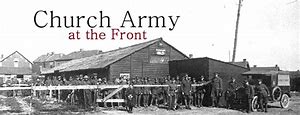

Images: Image: © Churcharmy.org
link: Church army image link

image: © Salvation Army.
Hospitals.
Many places were converted to hospitals to care for the war wounded and injured. These were often renamed. Our local mental hospital Winwick Asylum was renamed “The Lord Derby Military Hospital” and many private houses became small out-station or auxiliary hospitals. The local workhouse became the Whitecross Institute and was run by the first Warrington’s female doctor Dr. Mary Nobel. Raddon Court run by the four Miss Broadbents was another local auxiliary hospital. Image IWM. Lord Derby hospital

Image. Warrington Guardian (c) Image.

Image. © Red Cross. An auxiliary Red Cross Hospital.
Link: British Red Cross
Link: German Red Cross: German and interntional Red Cross

The Home of The Misses Broadbent became a small hospital (WM photo)

The misses Broadbent of Eadley Courts (WM Photo)
Field Hospitals in the war area offered both immediate medical treatment most importantly read and wrote letters for the injured who could not read or write.

Image. © Red Cross. Letters home dictated by patient.
It was observed that the information sent from field hospitals and the 'Recreation Huts' run by charities were more accurate and informative to relatives than the brief official communications of the authorities.
Link to page:
War Blinded.
The St. Dunstan’s Home for Blinded Servicemen raised money with a pamphlet distributed in Warrington illustrating the case of a Harold Thompson (aged 21) formerly of Crossfields soap works.
With no national health service the physically and mentally wounded, as well as normal people, were then totally dependent on charities for hospital care.

A picture of 'Blinded For You' from the painting by Richard Caton Woodville. This image was one of six used in a set of postcards in aid of Blinded Soldiers and Sailors. The postcards were commissioned after St Dunstan's was flooded with casualties in 1916, and urgently needed to raise funds to accommodate the new patients. Image IWM ©.
St Dunstans charity ha schanged its name to Blinded Verterans UK
Link: Blinded Veterans UK
Belgian Refugees.


Refugees from Belgium were helped by charities in UK and in neutral Netherlands. The refugee numbers were very great and some were helped at a camp at Penketh.

Image: IWM. Girl Guides teach refugees English around a garden table in the United Kingdom during the First World War.

Lancashire Women Poster IWM poster collection. From early in 1914-18 war before compulsory service by conscription.
Ordinary Charities.
The ordinary non-war effort charities that provided for the medical and poverty relief of the normal civilian population still had to function and raise funds and give care when the general population's ability to give was most stretched.
War work.
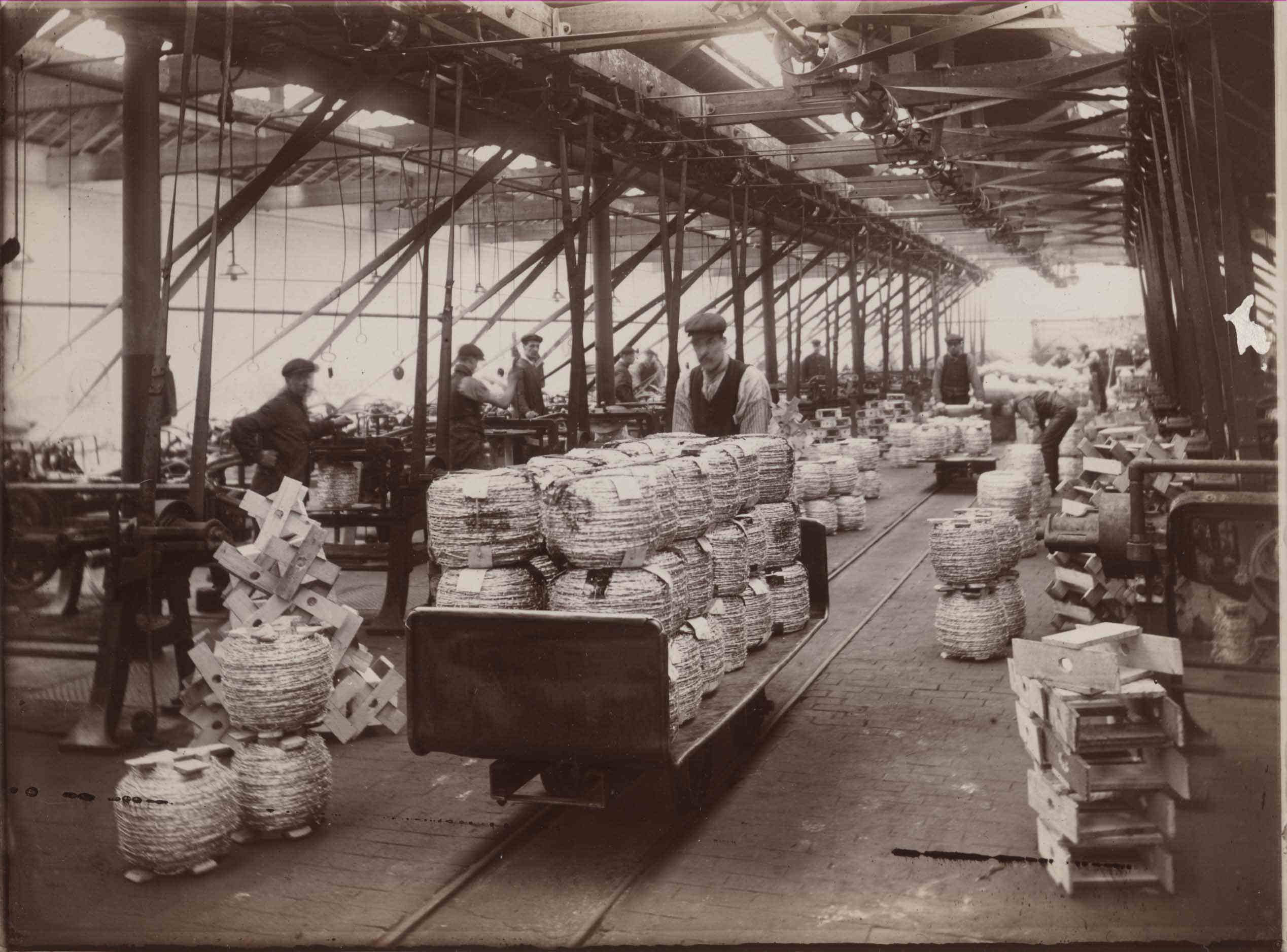
Barbed wire being made in Warrington.

Collecting books, newspapers, magazines for the servicefolk at the front, using war wounded personnel to collect. (WM photo)

Few jobs for war injured, and disabled men effectively 'outcast' from society. (WM photo)
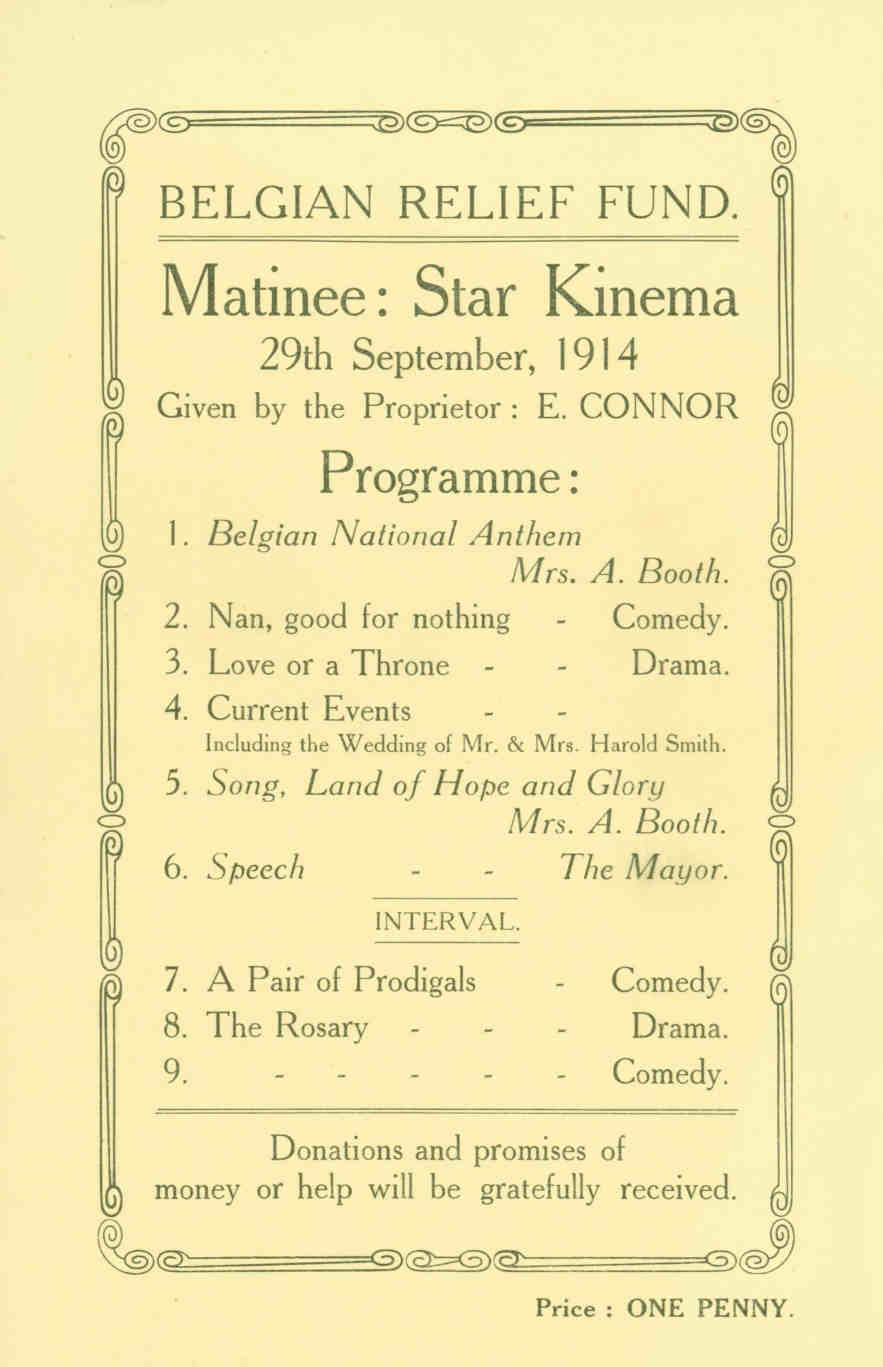

The Star Kinema of Leigh played a part as they had staff as POWs. (WM photo)
Women at "war work" changed the nature of women in society during and after the war

Photo from Warrington Museum archives (WM photo)
Please visit the archives in Warrington Museum.
You wil receive helpful advice and learn of the major effort made by Warrington folk to help others..
Closing Christmas Tea.
The meeting closed by members and visitors enjoying the cakes, pastries, cakes and trifle provided by members.
Thanks.
Our members and visitors would wish to thank Philip Jeffs for his most enlightening and well researched talk.
- 2017-11-09 Bridge to Bridge
- 2017-10-12 Lunt Meadows
- 2017-09-14 Rail Transporter Bridge
- 2017-08-10 Police Museum
- 2017-05-11 Lord Haw Haw
- 2017-05-13 Warrington Museum Events
- 2017-04-13 Chat Moss Project
- 2017-03-09 Culcheth Workhouse and Pauper Apprentices
- 2017-02-09 Weavers' Cottages
- 2017-01-12 Pretoria Disaster





